

Mini Maxi 650
Kiraucassis mini maxi 650.
After racing a 70ft beast in the most remote parts of the world, time to tame another freak of the seas…
About Kiraucassis
No Technology
4-5 hours of sleep per day
+20kts top speed
SCOW bow shape
122 m^2 sail area
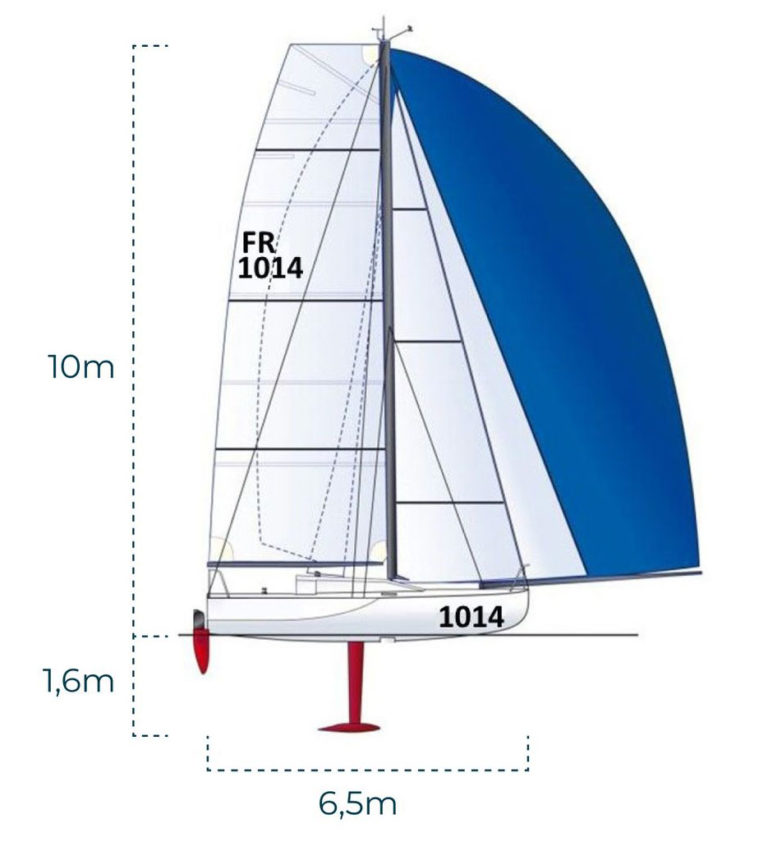
- Length : 6.5m/21ft
- Beam : : 3m
- Weight : 950kg
- Draft : 1.6m
- Air draft : 10m
- Sail area upwind : 44m2
- Sail area downwind : 115m2
- Sail ratio/weight : 1.2
- Number of sails : 7
What to know more about the mini 650 class?

The Mini 6.50 Class is divided into production boats and the prototypes.
Some rules are common to all boats: 6.5m LOA max, 3m beam max, no communication, etc.
Prototypes are allowed to have daggerboard, canting keels, ballasts, carbon mast…etc. The mast is also a bit taller (11m instead of 10m for the production boats), the keel a bit lower (2m instead of 1,6m).
Let me introduce you to Kiraucassis.
She is a Maxi 650 from IDB Marine shipyards in France.
She is 6.5m (21ft) of raw power, built to cross oceans really (really) fast, single-handedly.
On my first day test sailing her, we would already reach 17+kts
She has a rounded bow, a design called "scow".
Many say it’s ugly, some love this… in my opinion, it makes her faster than the competition when reaching and downwind… that’s all I’m asking for.
Find out more about the design in my vlog.
the next boat to race single-handed across the Atlantic?
My next project is to race the Mini Transat, a race across the Atlantic single-handed on a one-design fleet.
The Mini 6.50 class is an incubator for innovation. Most of the technology and design concepts you find today in the IMOCA class have first been tested (and crash-tested) on a mini.
I chose to go for a scow, more powerful and stable downwind, the Maxi 650, from IDB marine, see more specs here.
Can’t wait to get on the water with this new toy to see what it can give. Until then, have a look at the surfs these tiny offshore beasts are capable of.
Start typing and press Enter to search

Sailing the Vector Mini 6.5
- August 27th, 2023
- Sailing Yacht
Today was a glorious day! One of those perfect Sundays you wish they´d never end. Why? Because I got to meet a great guy and sailor plus had the pleasure to take a dash out with him. In this you might think this isn´t something special, maybe, but in this case it was: My first time actually sailing in a Class Mini 650 racer and not with just any odd old Mini, but a brand new Vector 3 boat, one of the latest generation sporting a scow bow.
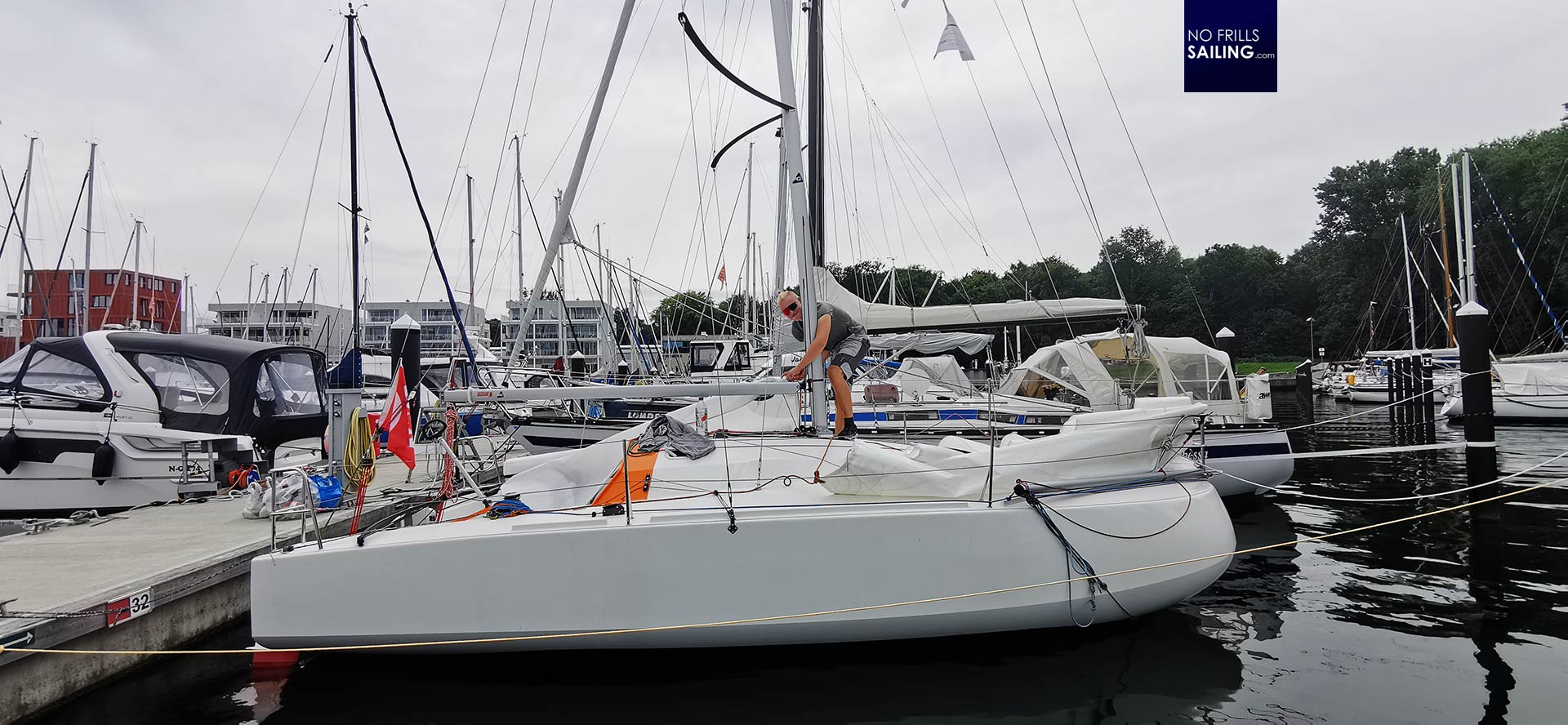
I met Hendrik Decker some years ago as he worked for a commissioning partner for our company in the Northern part of Germany. I liked him at an instance: He is one of those guys you simply can´t imagine they´d ever have a bad day or they´d ever be in a bad mood. Hendrik has always the brightest of a smile in his face, polite, open and so cheerful that you have to be in a good mood as well when with him. If not for boatbuilding (he is a skilled boat builder craftsman working on his master workman certification) he surely would have a great career in modeling.
Meeting Hendrik aboard PLAYGIRL
I climb aboard his boat right after noon, warmly welcomed. His Mini is christened PLAYGIRL and this is such a great fitting name for his favorite toy! He leisurely sits on the cockpit flooring, fitting some ropes. The sails are already prepared and fitted to their halyards and sheets. Apart from two or three more details, we are ready to go.
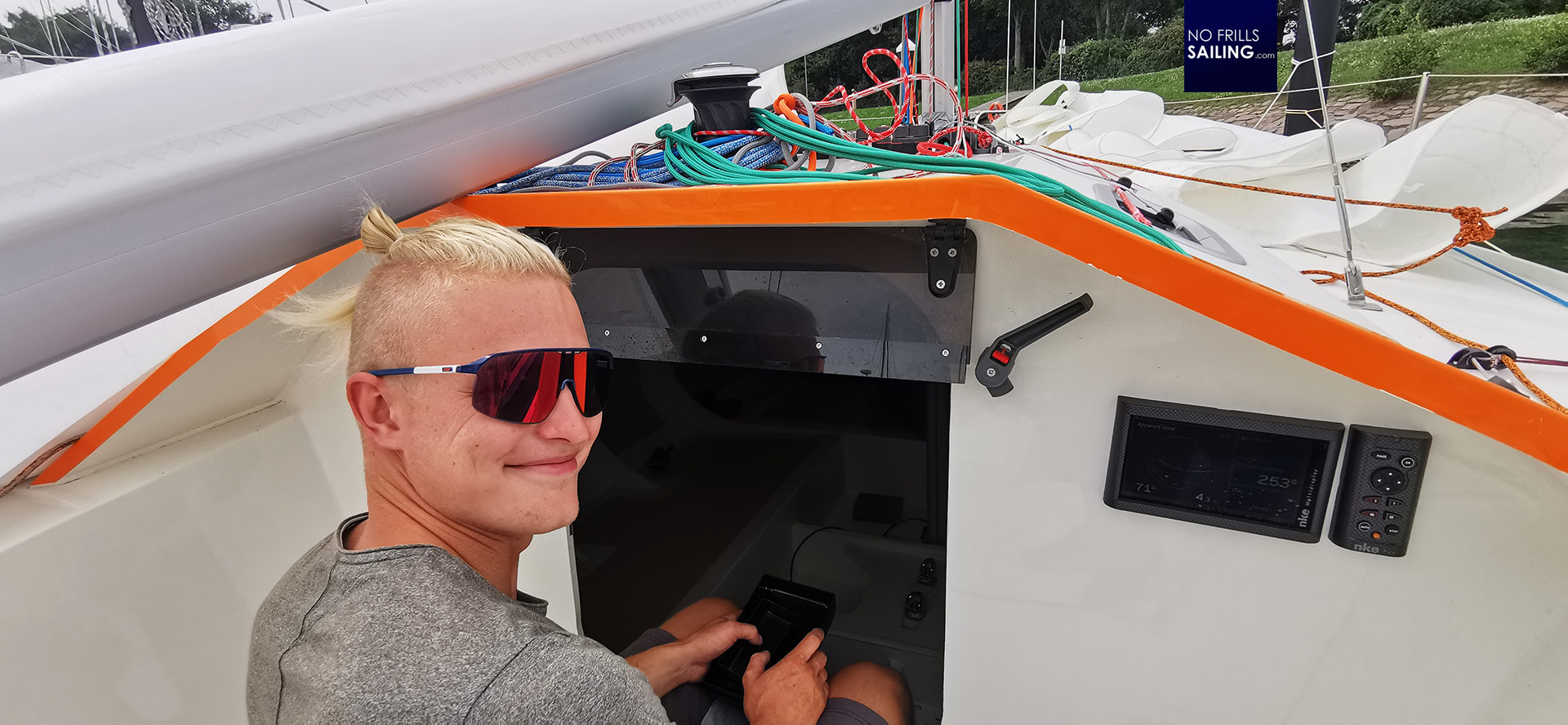
Putting my little backpack down below, I am again puzzled by the enormous volume the modern scow bow creates inside. Since the Mini is just 6.50 meters in length and has a width of 3 meters, the first generations of Mini, then predominantly pushed by Frenc boatbuilder Pogo, where fast planning flukes but cramped and dark oceangoing sheds. Not so the Vector Mini. I´d say her internal volume matches hat of my 8 meter First 27 SE, at least in the saloon.
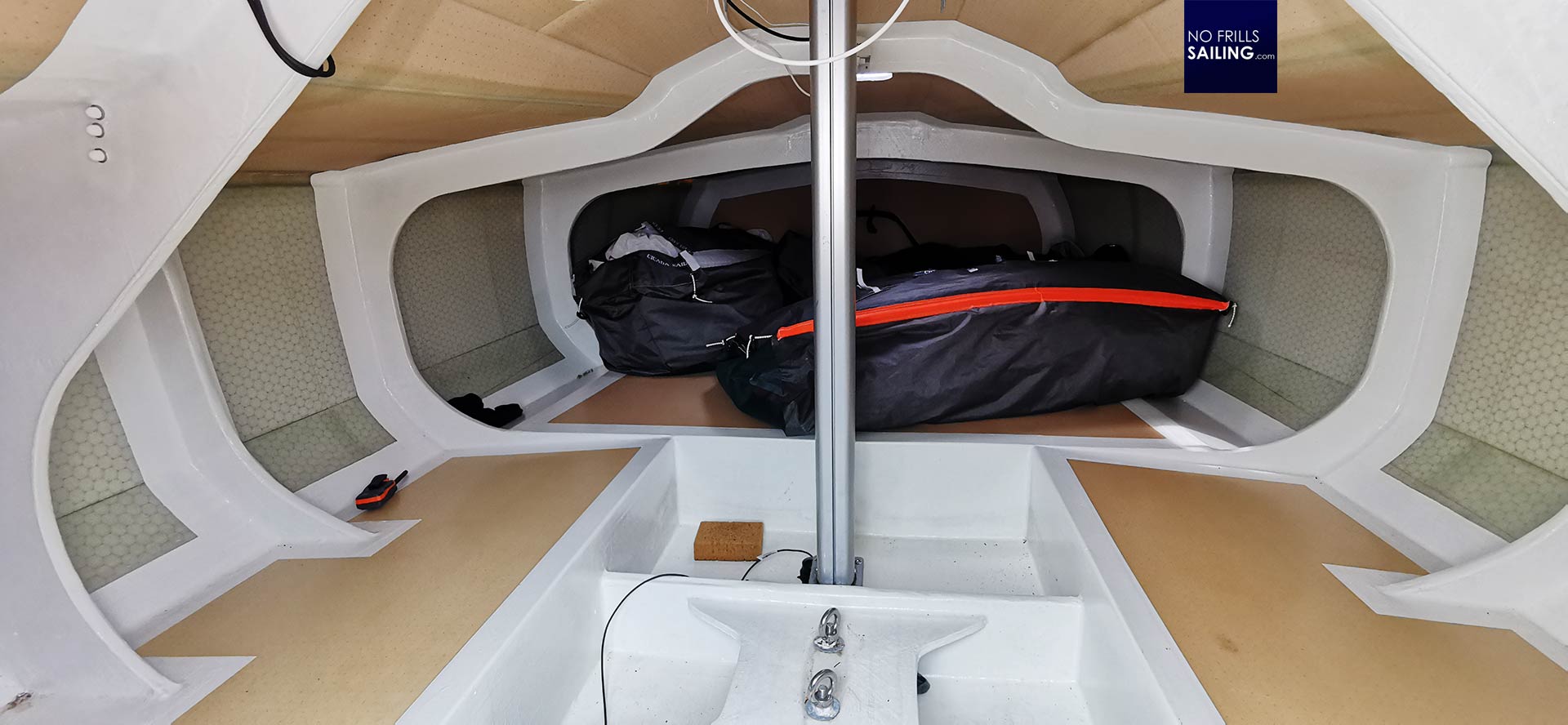
I wonder around on deck making myself familiar with the running rigging, the cockpit layout in particular and the basic stations where Hendrik later would be working the boat. Today, I decided, I would just be the guest taking pictures and asking questions, keen on witnessing a true solo racing sailor doing his work. Maybe I can learn something here today? No five minutes after my arrival he asks me to take in the bow lines – and off we go.
Casting off like back in sailing school
This, of course, happens with another surprise: PLAYGIRL does not have any propulsion system other than the wind. No engine. Not even a paddle. Hendrik smiles: It´s supposed to be a light racing boat, why waste precious kilograms for a heavy engine, fuel and spare parts?
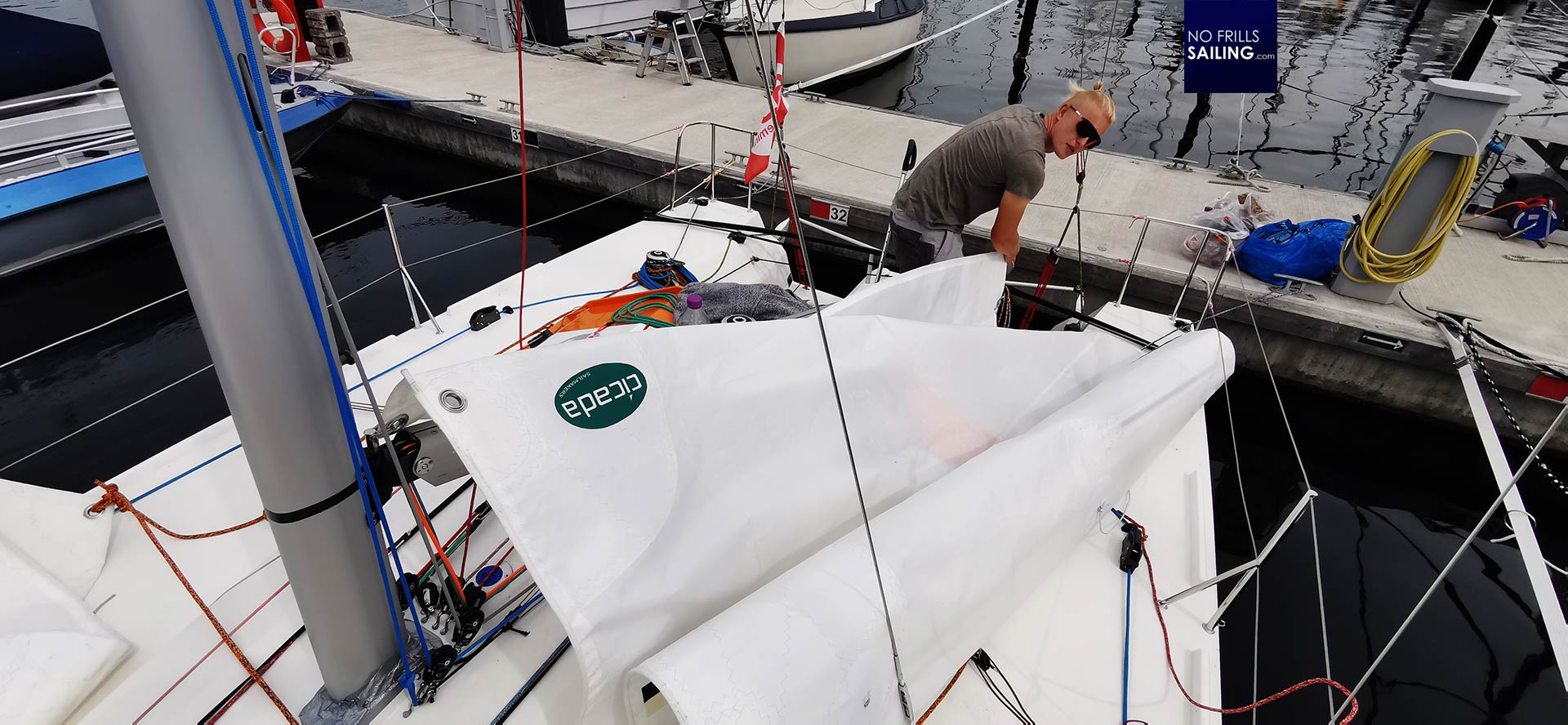
Wind forecast for this day was low: No 8 knots of true wind. A promise of a lush sailing day, no frenzy and no hustle. Casting off like in the old days in sailing school , where we all learned at some point to leave the pontoon slowly by hand and Jib. We are pushing PLAYGIRL out of her berth, slowly around the bollards. Hendrik jumps to the halyard and seconds later the Jib is hoisted, catches some wind and the boat springs to life.
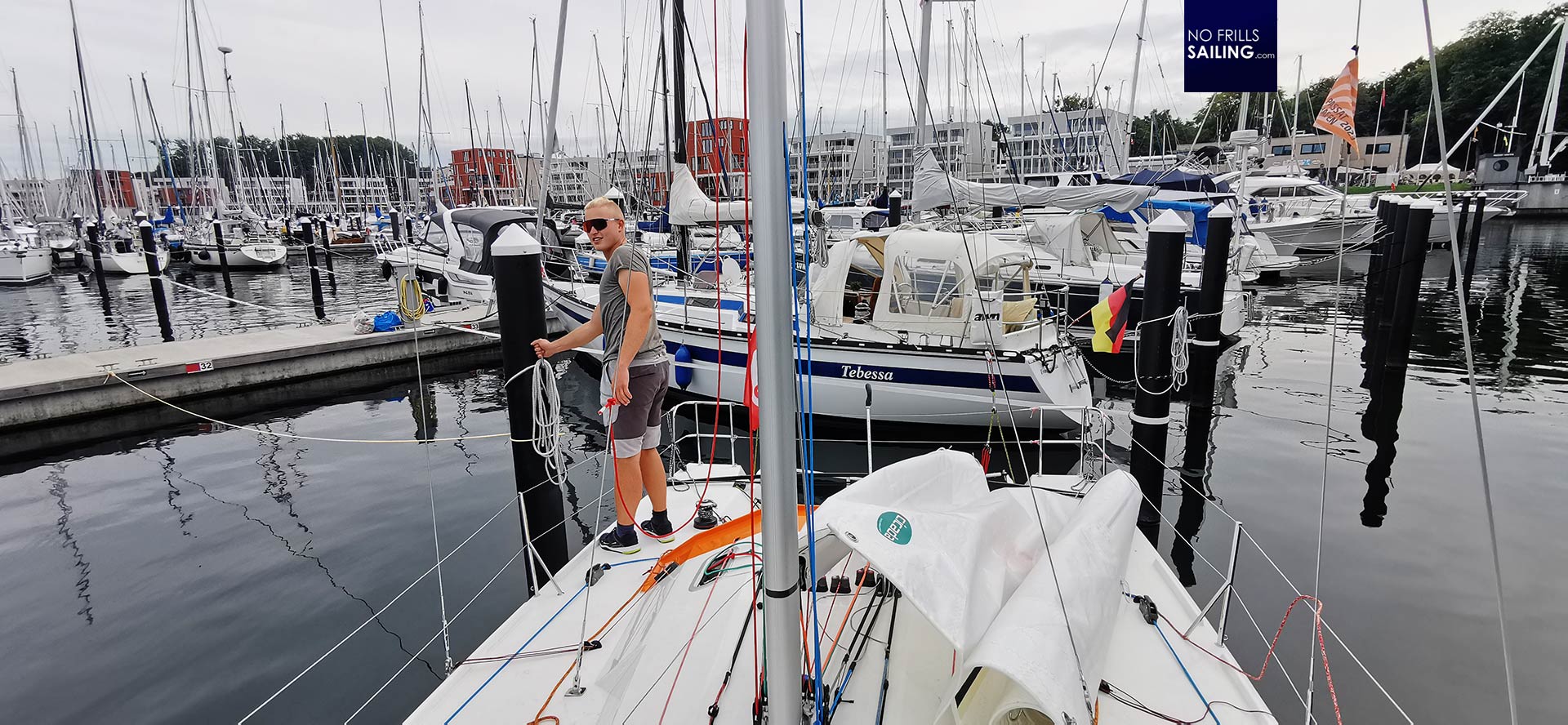
We leave the harbor into river Trave, just a quarter of a mile and we will be out in the open Baltic Sea. The mainsail is put onto the mast, again, just seconds later Hendrik has it hoisted, roughly trimmed and put to use. The boat even more speeds up: I´m always puzzled how easy and seemingly effortless light boats are pushed forward by even the slightest puff, something I absolutely loved about my GEKKO too.
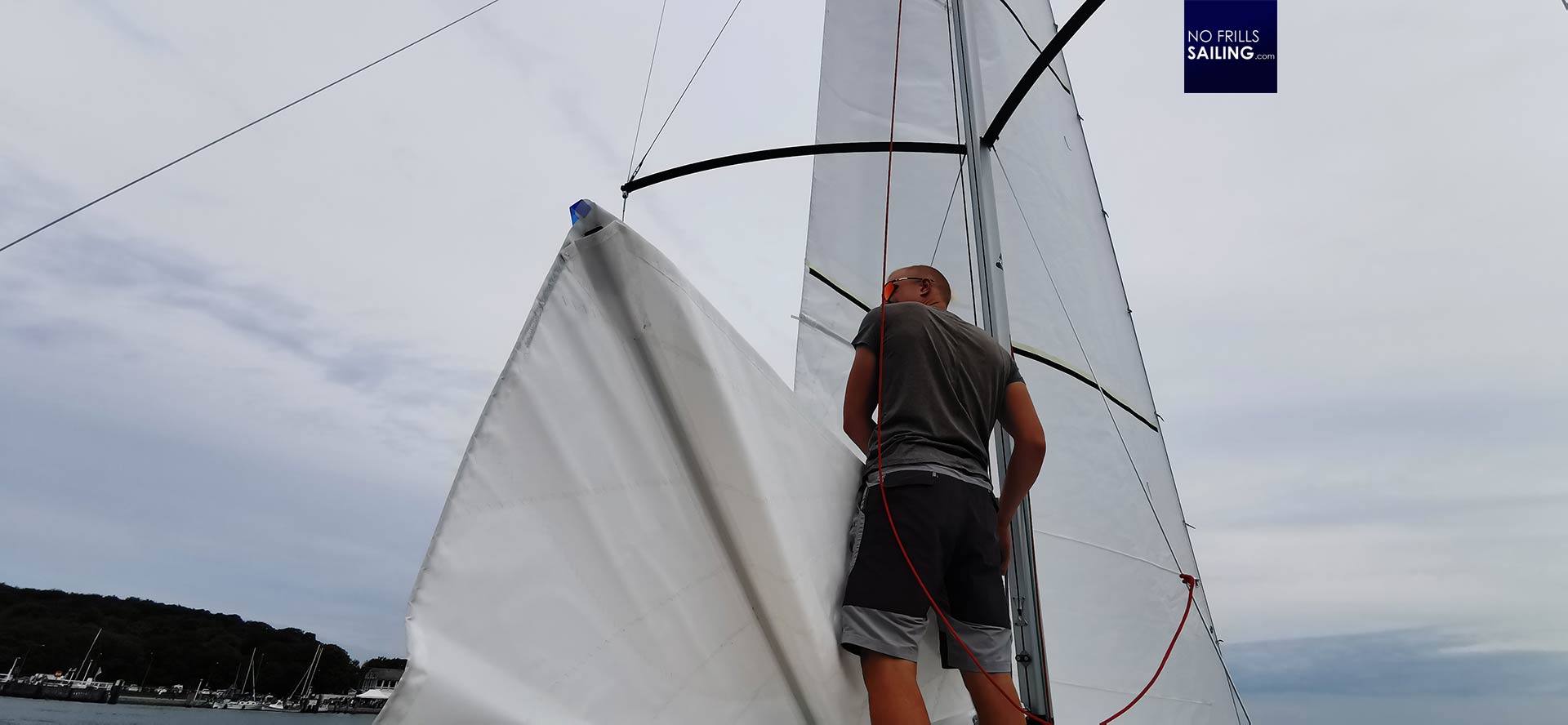
I am also excited to see how much less things you need to have fun sailing: There´s no engine humming, neither a combustion nor an electric motor is moving a propeller. There are no fancy laminate sails up in the sky. As the box rule of the Class Mini supposes every owner, this boat is equipped with simple, durable Dacron-sails. PLAYGIRL is a self-build. After receiving the hull, rigging and the keel, Hendrik fitted her himself sailing-ready. His budget have been approximately 100.000 Euros, which is reasonable and comparably low for a competitive racing boat.
The Vector Mini 650 – light & fast
After both sails are up, he trims the sheets and optimizes the mainsail with sheet and traveler . She instantly “gets up her arse” and picks up speed. Instantly, and I mean it, we enter planning mode. Which is fantastic: The wake is disconnected, we hear the soft and familiar “swoosh”-sound and glide over the water. He tells me that usually a boat speed of no more than 5 knots is needed to get her to planning mode. Amazing!
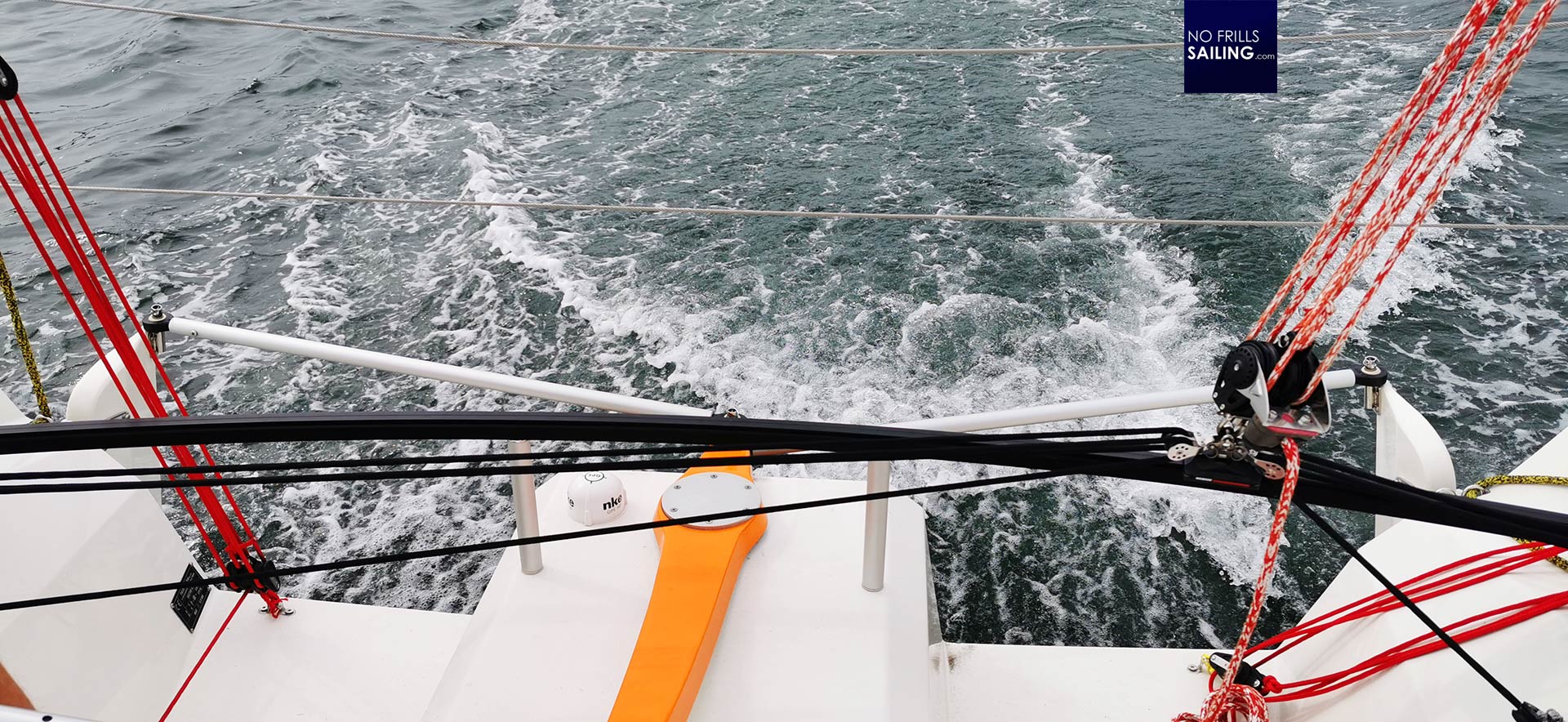
In this, she is absolutely silent. Well, of course we have no significant waves today and with some 10 knots true the wind speed is not that high, but nevertheless, I somehow expected the scow bow to be … louder. I ask Hendrik but he shakes his head: In his opinion the scow bow is actually even less noisy than the predecessor Minis. And he must know it since he owned a Pogo 2 before he decided to switch to the latest production boat Mini with a scow bow.
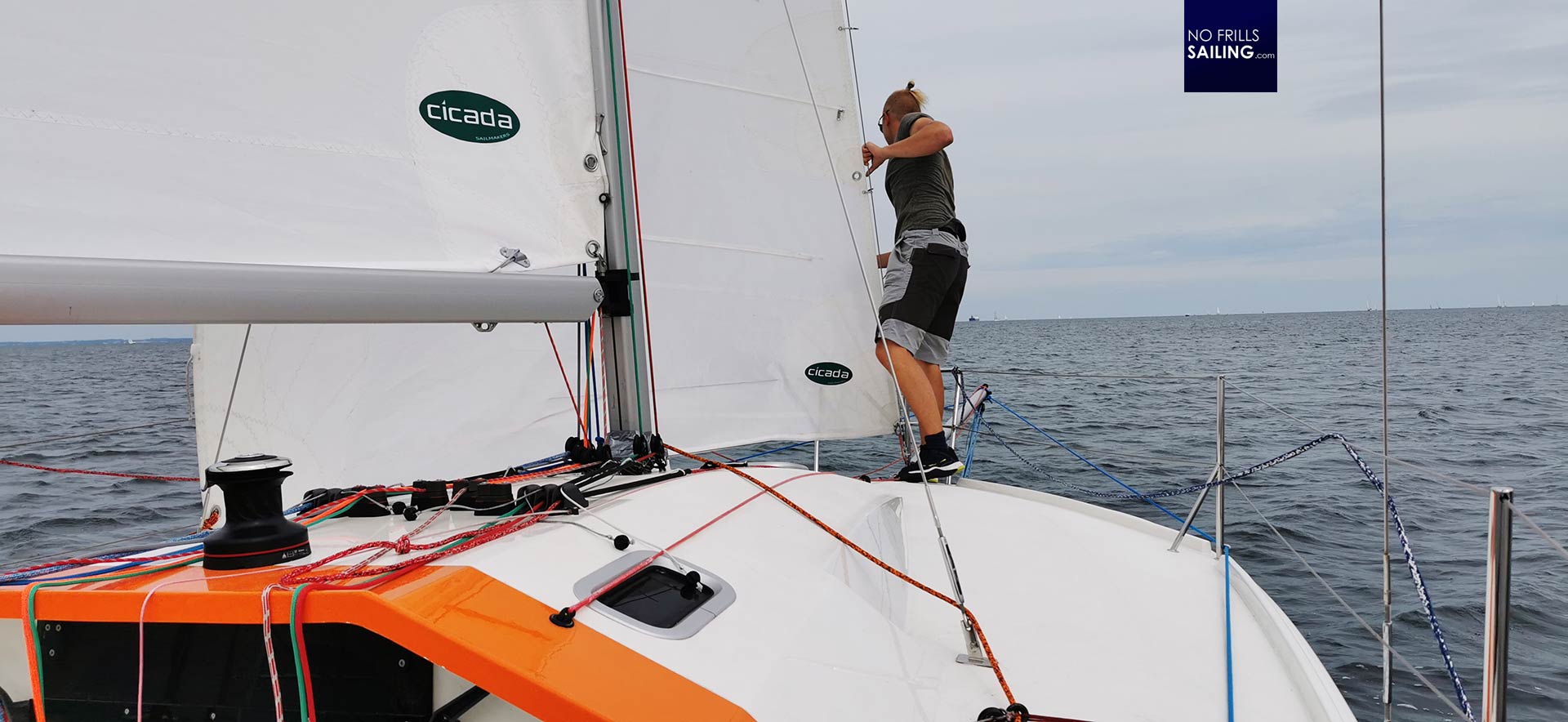
As we leave harbor and glide on a beam reach, the restless skipper is on his feet again and jumps to the bow. Of course the conditions today are screaming “Gennaker!” and this is totally why I was coming to visit him today. So let´s do it, let´s get out the big blister and see what this boat is capable of!
Time for the Crown Juwel: Gennaker-sailing!
The bowsprit system of the Vector Mini is simple and effective. Other than on my old First 27 SE the bowsprit is not extendable from the boat´s inside but swung out and fixed in position by a storng Dyneema bobstay and two supportling lines to either side. Setting up the bowsprit thus takes some more time than just pulling it out, but therefore I find that the fitting of the bowsprit looks at least much more rigid.
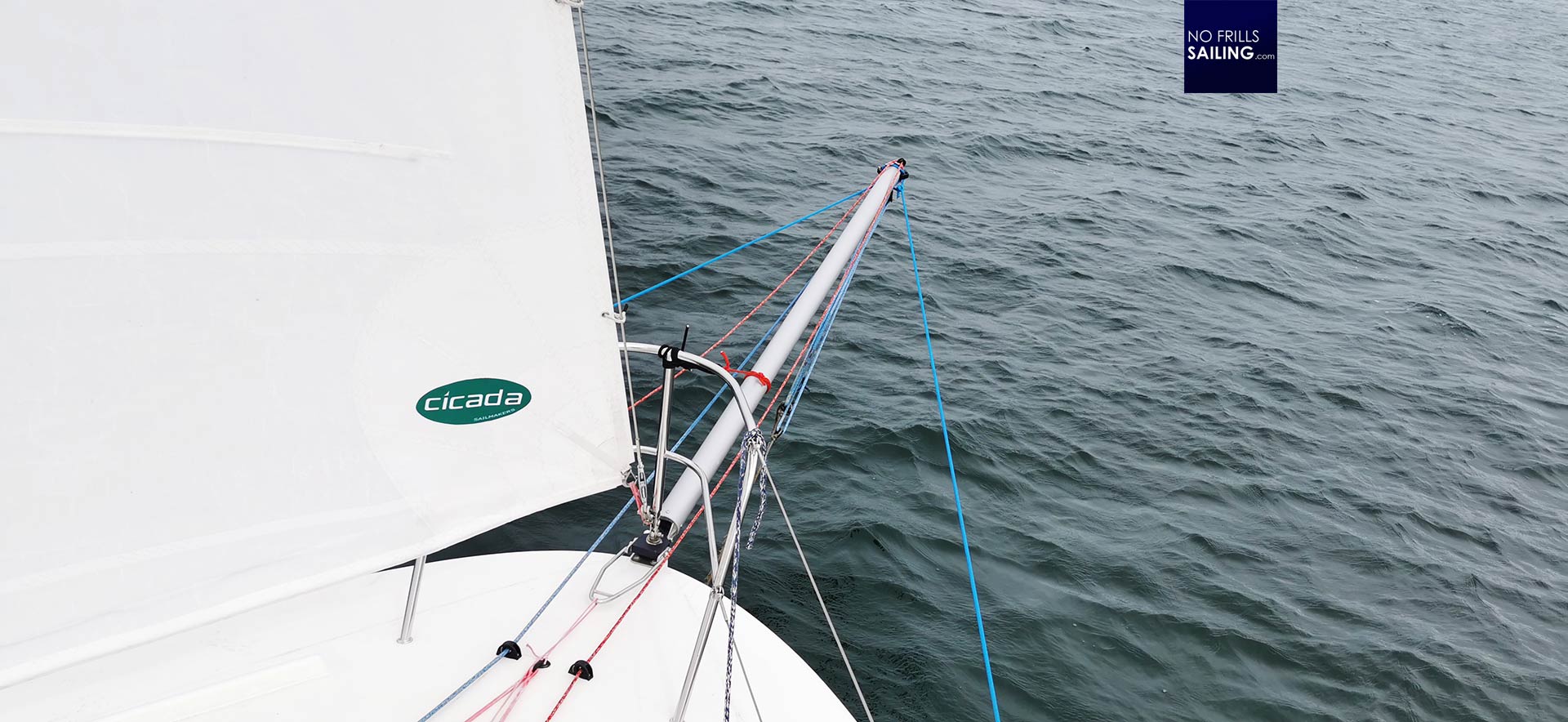
The Gennaker on the Mini 650 is impressive: 80 square meters of Nylon. That is the same sail area I had on the First 27 SE/Seascape. Just that the Mini has a weight of just around 1.000 kilograms (for the famous Mini Transat the boats must weigh even less, 990 kilogram) That´s the same sails area for a significantly lighter boat. I am excited to see what happens when it is hoisted!
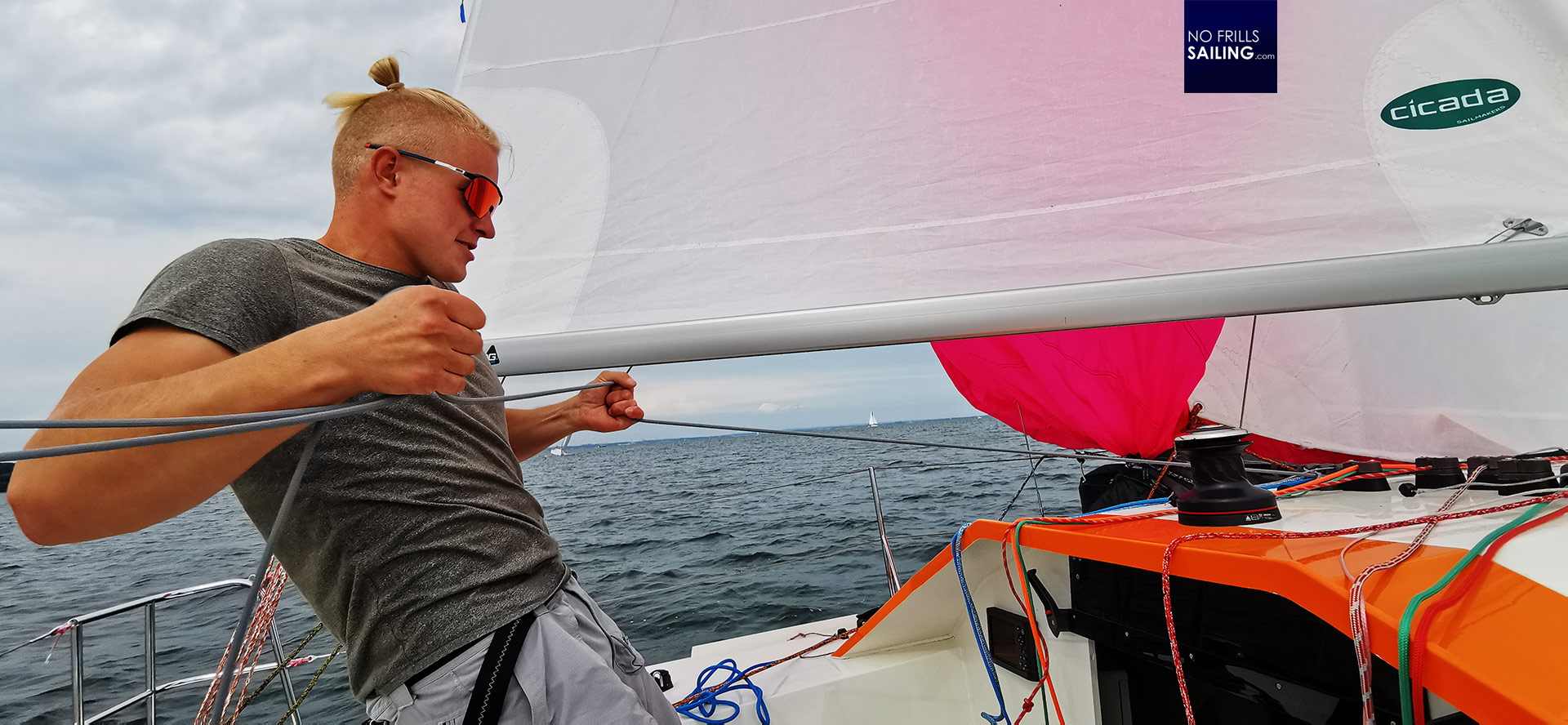
Prepping the Gennaker to be hoisted is something every skipper has to practice, as I know by myself very well. Hendrik surely went through the same training, as he admits, with sandclocks and Gennaker dragging as a drift anchor. Connecting the sheets to the Gennaker, tack line and halyard takes two minutes at most. He bears away a bit and opens the main, then, beefy and fast, he pulls the halyard.
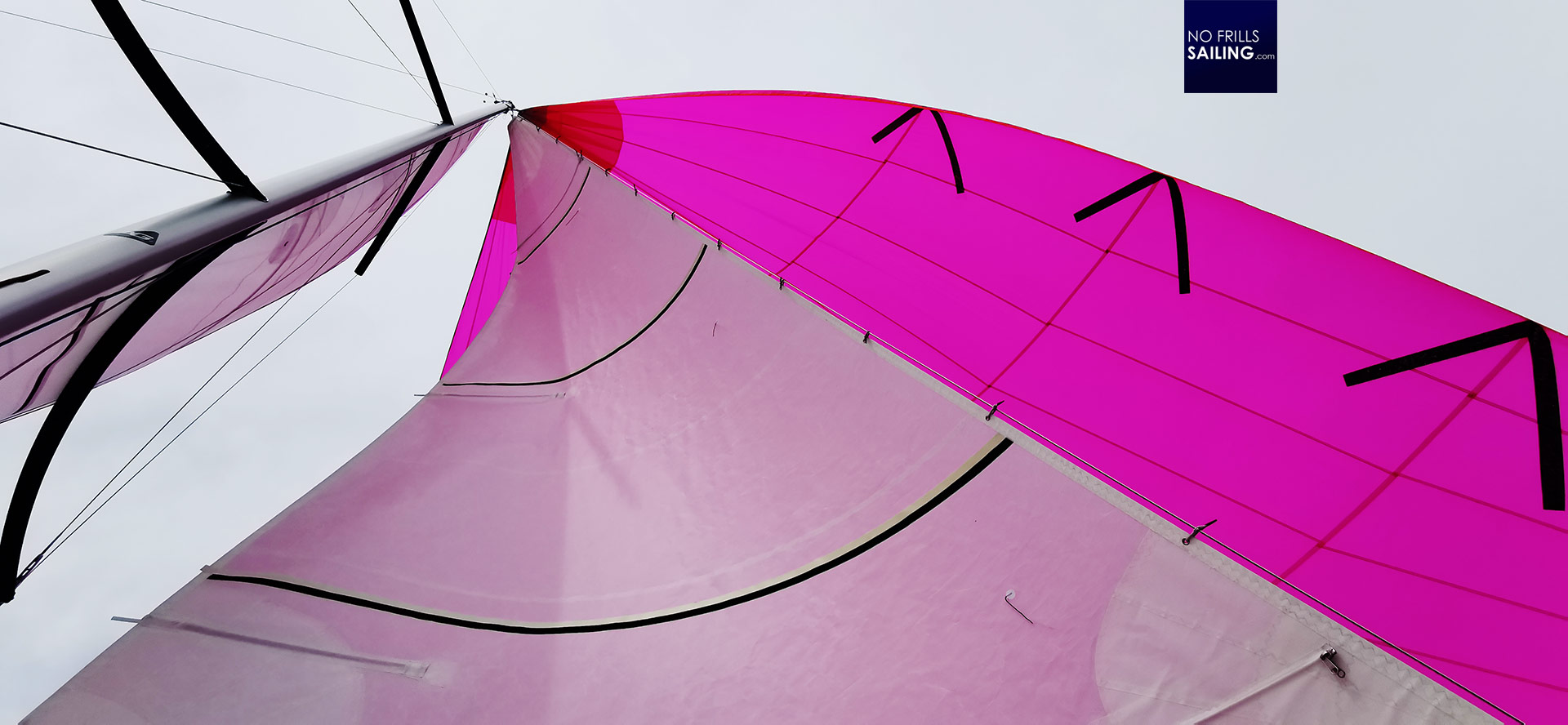
The kite is up in a matter of seconds and I feel the all-too familiar feeling of speeding up. It´s a sensation that is only sensed with a Gennaker – almost no heel, top acceleration but literally no hustle, no sounds, no shocks. Just speed as it happens. I love it! And Hendrik apparently too, judging by his smile.
Flying under full Canvas
He left the Jib up, something I never tried on GEKKO. Wind speed has increased a bit more, with 12 to 15 knots now and the boat is sprinting down. There is literally no boat out today (and there is quite a fleet utilizing this wonderful Sunday for sailing here) that would be faster than us. What strikes me again (as a reminder of my time with GEKKO) was that all other people of the surrounding boats are happily waving and yelling their Ahoi as we dash by: Something you just get with a small, cute and fast boat.
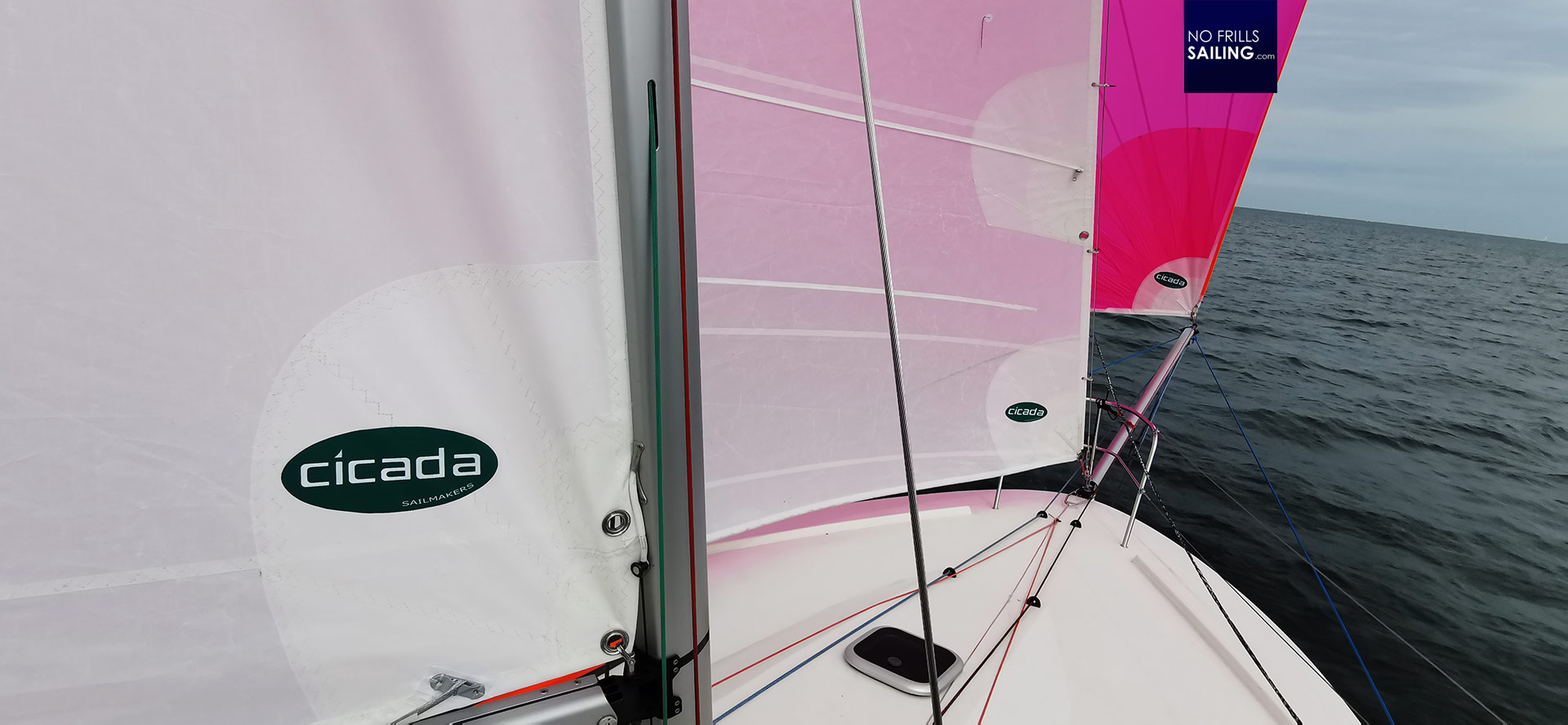
PLAYGIRL steadily sails through her natural element. As the Gennaker is trimmed and Hendrik cleared the lines a bit, we sit on the coamings next to each other and chat. The boat is doing a steady pace at 10 knots and we can sit down and have a nice little chat. “Couldn´t we just go on and sail to Denmark?”, Hendrik suggests. He is going to participate in famous Vegvisir Race next week and would love to utilize these favorable wind conditions to reach starting place in Nyborg.
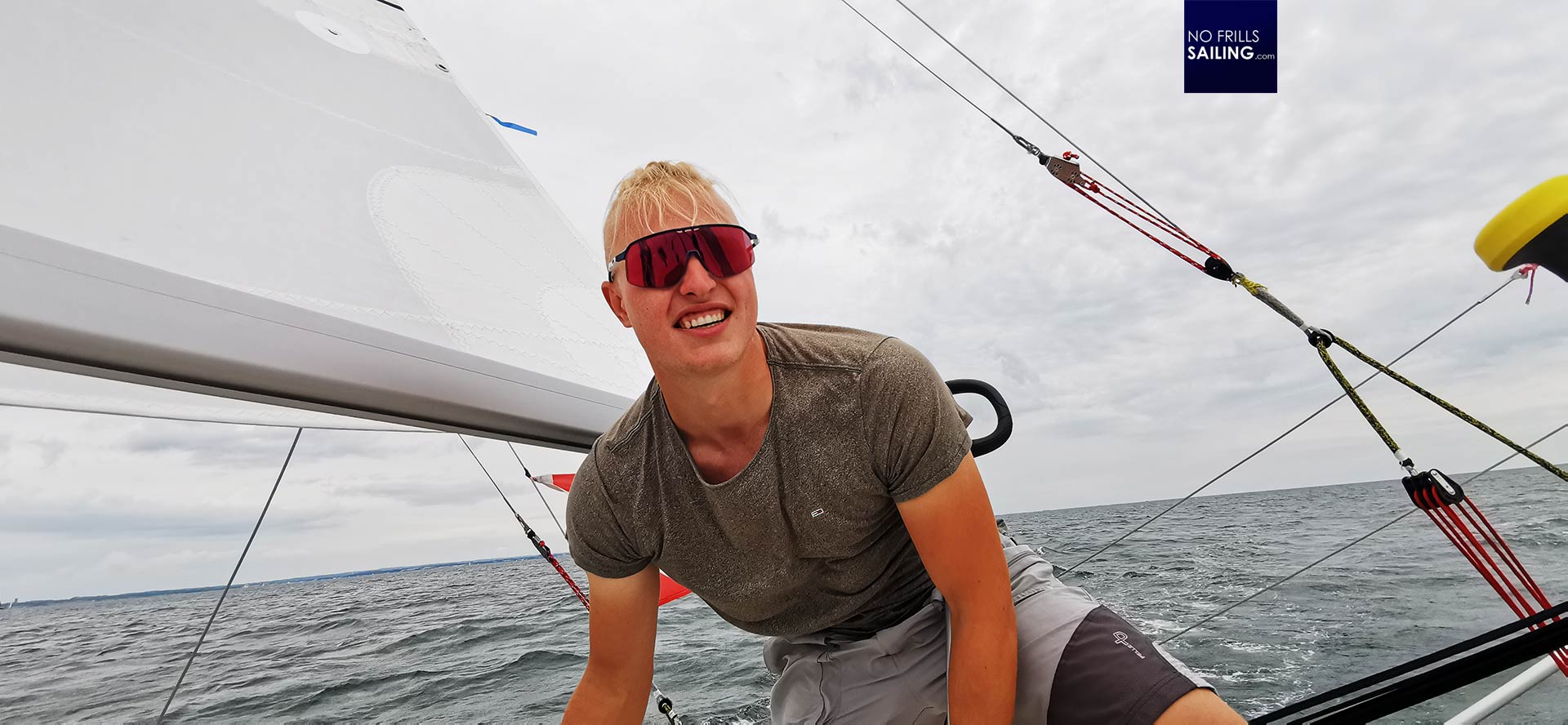
We chat a bit about single and double handed racing and his ambitions. As a keen sailor he had participated in quite some regattas, like the World Championships double handed: “But there´s nothing to write home about”, he says. Much better was his performance during Travemuende Week not so long ago: Second place in his class. That´s quite something!
By the book: Gybing with Gennaker
As we are speeding downwind and begin to put quite some distance between us and harbor, I fear that he really might sail on to Denmark. Time to lay in a course that would bring us back home, I think and ask: “How do you gybe with a Mini 650 in solo mode?” I do this because this was the most concern I had back in the day, not knowing if I would be able to control both sails in a maneuver. And here we have three sails to control.
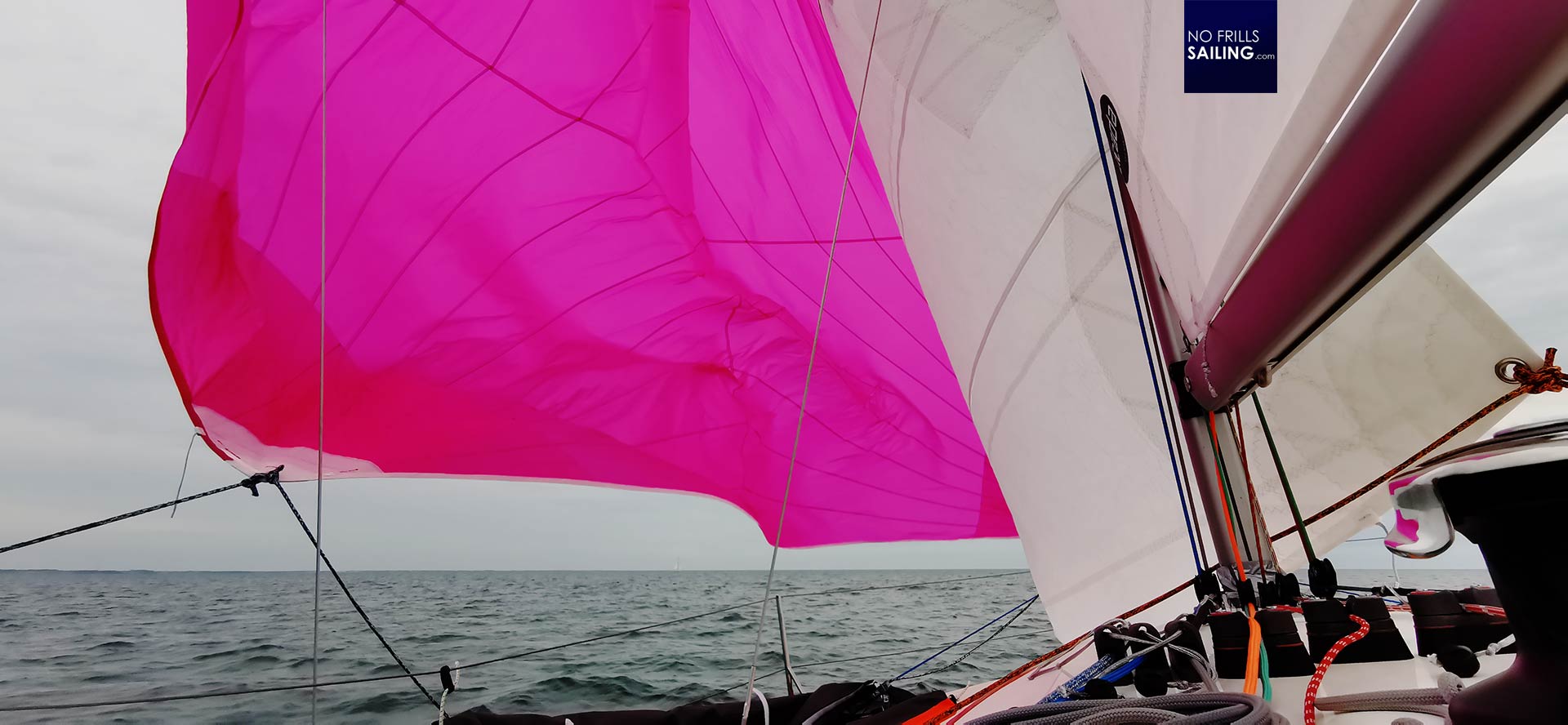
Hendrik smiles and agres: Let´s do it! I go down to the cabin because I knew that he´d need all the space of the cockpit to dance around and have the lines at hand fast. At first he puts the boat to a near running point of sail and sheets in the main. Then he backwinds the Jib, thus preparing it to be put to the new sheet at an instant.
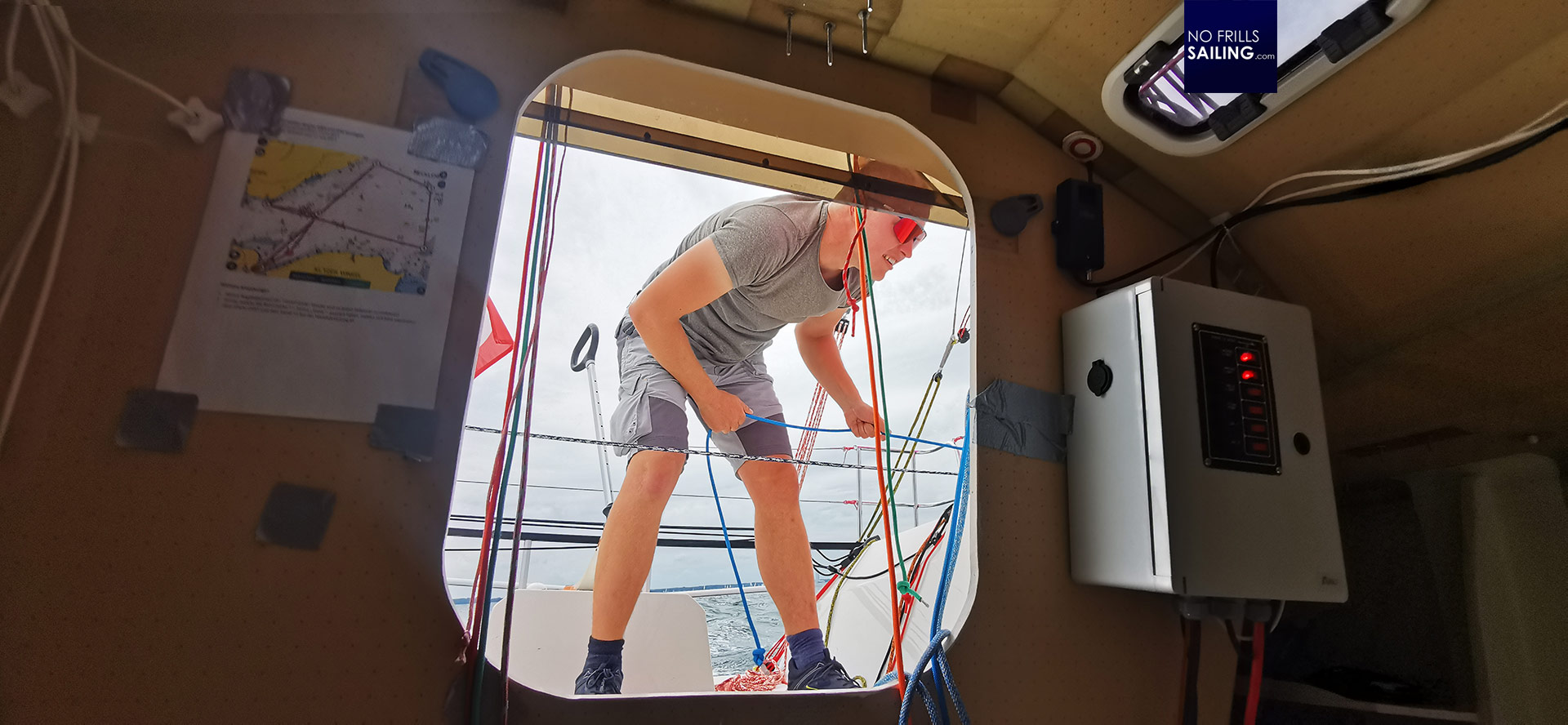
Not by autopilot, but by controlled pushes on the tiller he puts the stern through the wind, slowly at first, faster after the mainsail changed sides, the pulls the Gennaker sheet to get it to the new leeward side fast.
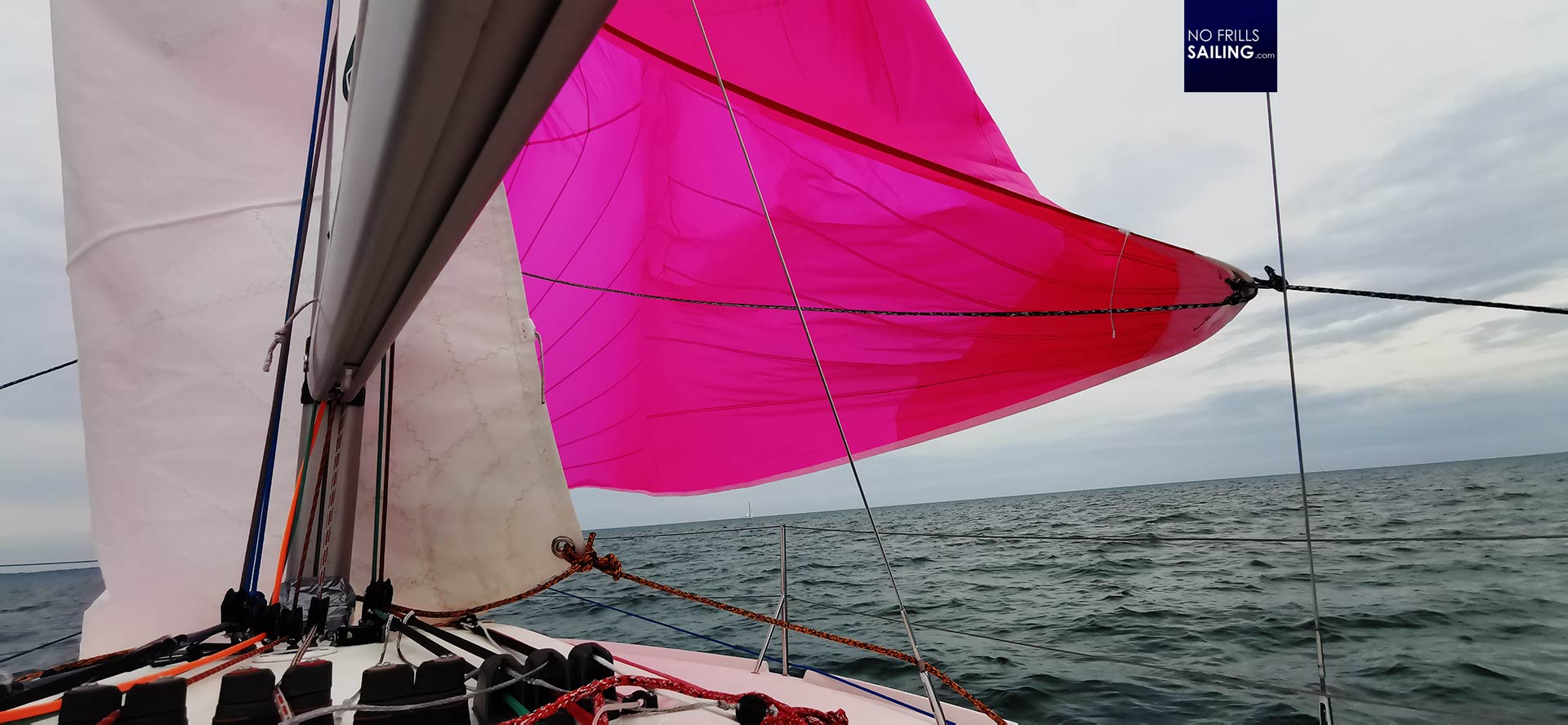
The whole maneuver lasts less than a minute. An indicator for sailing skills. After the Gennaker is up on the new leeward side Hendrik releases the Jib sheet so that the last sail can change sides too and the maneuver is completed. Some more cranking on the winches and a minute after I wished to the the maneuver it is already executed.
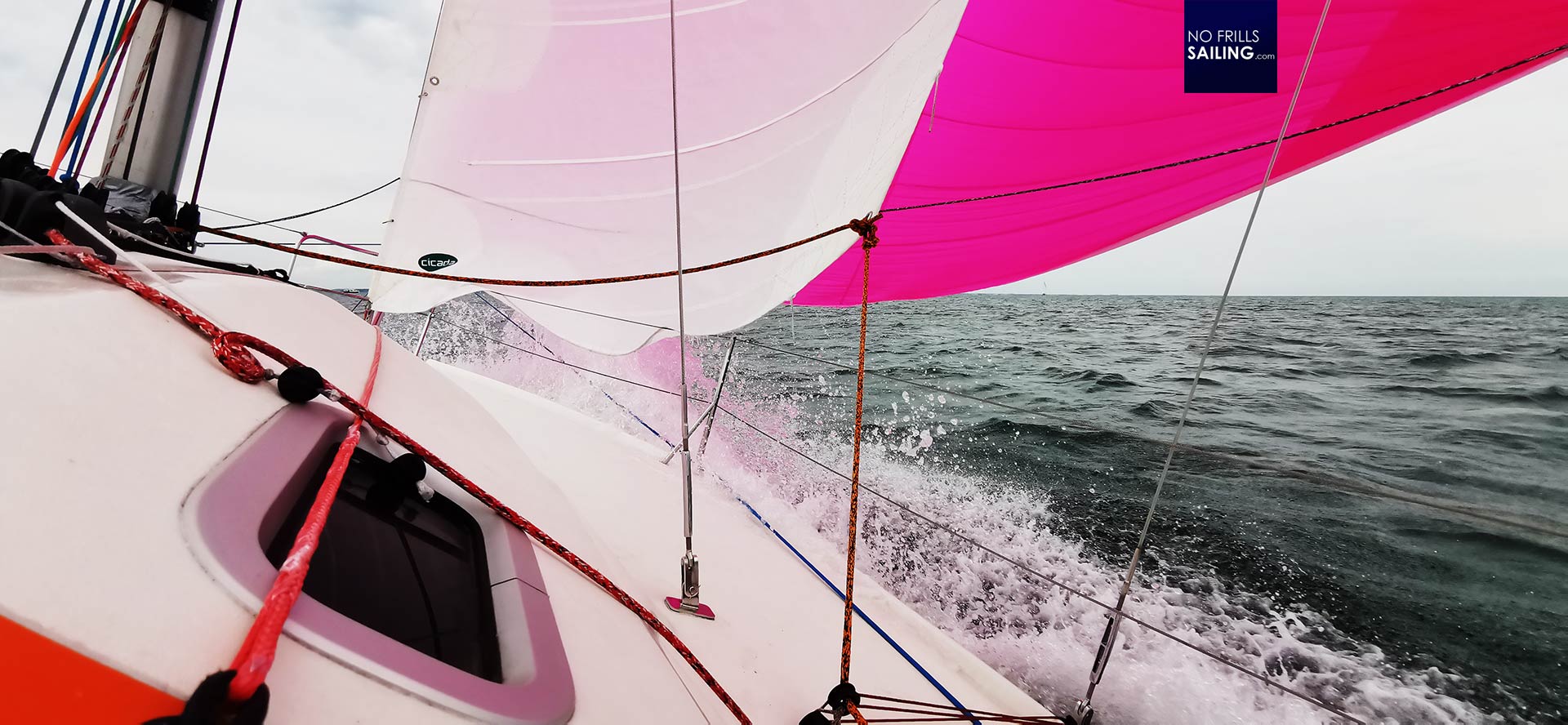
On the new bow we have a different angle hitting the ever building waves. Strangely enough weather forecast proofed again to be wrong today as the wind speed increases by the minute. With 15 knots and building, we speed up even more. There´s always a “chocolate bow”, we say in German, and its true for the Vector Mini as well. Today under these specific circumstances it clearly was the portside bow as the boat now has definitely much more rigid movement. I´m interested to check the data …
The speed potential of a Mini 6.50 Scow
We started today at some 10 knots TWS on a beam reach of which the boat utilized roughly 7.5 to 8.5 knots under standard sails. This is pretty impressive. After hoisting the Gennaker wind had picked up speeds to 12.5 knots of which PLAYGIRL was able to squeeze out 9.2 to 10.4 knots of boat speed.
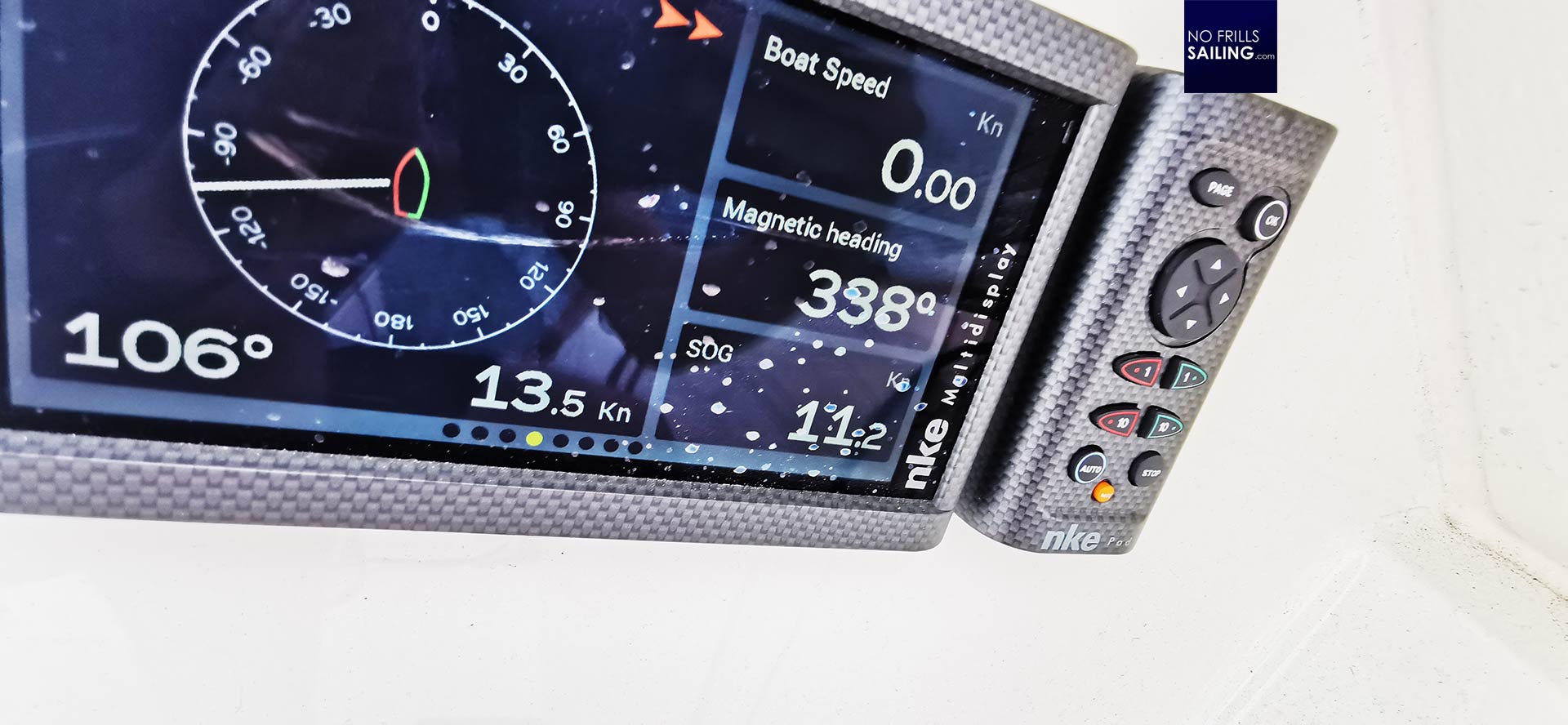
Right now with quite a nasty short and choppy wave pattern beginning to develop, the boat does an impressive 13.5 to 14 knots boatspeed in a 18 to 19 breeze. First boats around us are sailing reefed but Hendrik has no apparent motivation to take down the Gennaker. “It´s too much fun right now!“, he smiles brightly. I am really impressed by the performance of this scow bowed-hull!
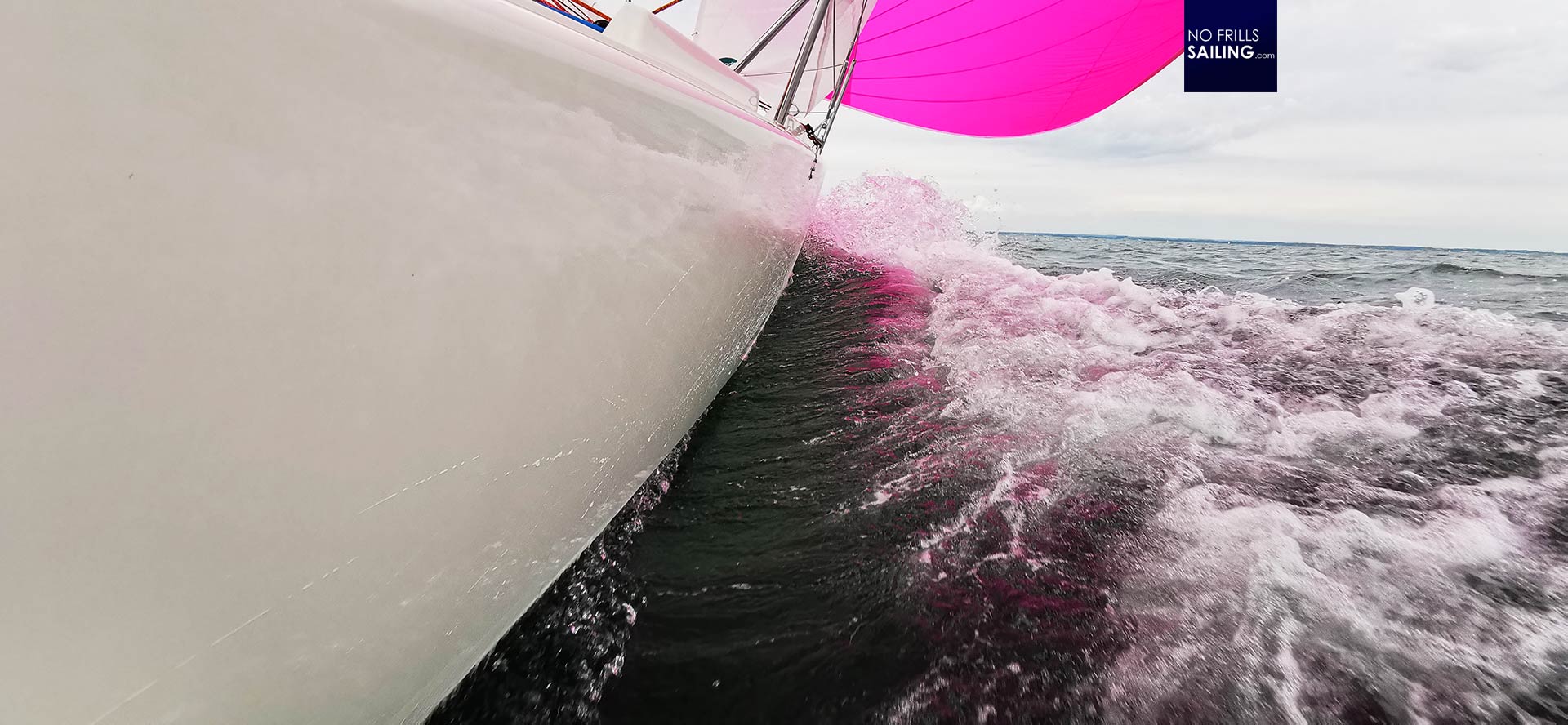
These boats are definitely not “beautiful”, at least not for me. I remember my excitement when I first saw the renderings of the then brand new Pogo 40 S4 from the side – a worthy successor to the very beautiful Pogo 40 S3, I thought. But then I saw the next rendering, the wide scow bow, like a duckbill. Just plain ugly. And I still cannot really appreciate any beauty in the scow design, I must admit. But what I can definitely appreciate is the power and the performance.
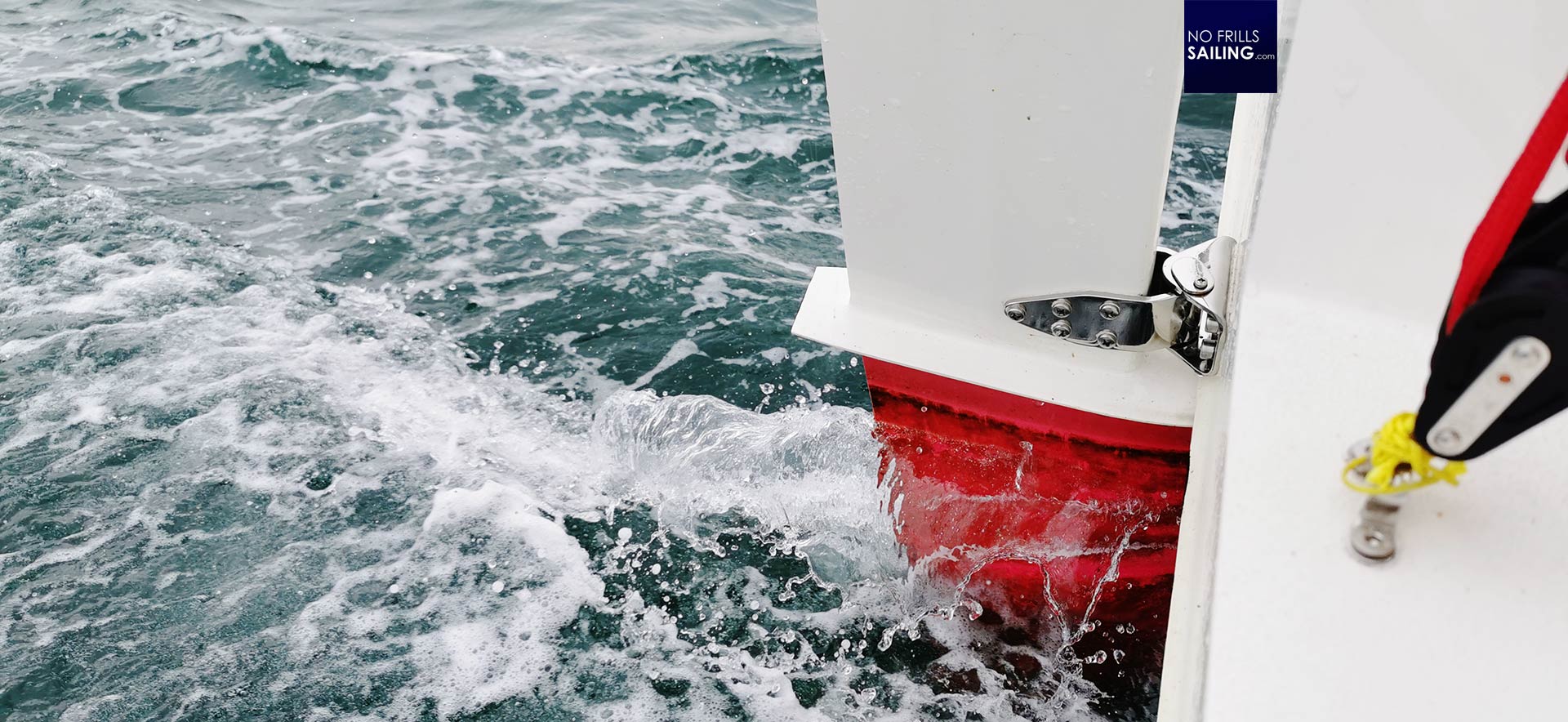
There are some more new things incorporated into this Mini 650. Like the horizontal fins at the waterline on each rudder: These should improve a clean tear off of the water at the edge. Something I can remember was of importance to me on GEKKO as well . “I am not that crazy though”, Hendrik says: “There are Mini skippers who saw off the boom at the end and the ends of the screws inside to get off a few dozen grams from the boat´s weight …”
Gorgeous solo boat control
As wind picks up speeds even more and right from where we want to go dark clouds heavy from the rainwater they carry start to race toward us, we decide to go home. At this moment we have been out for some two hours right now and I´ve seen quite some impressive performance both by boat and by her skipper. “I am curious how you get down the Gennaker”, I tell Henrik, honestly eager to learn how about the code of conduct from a racing skipper.
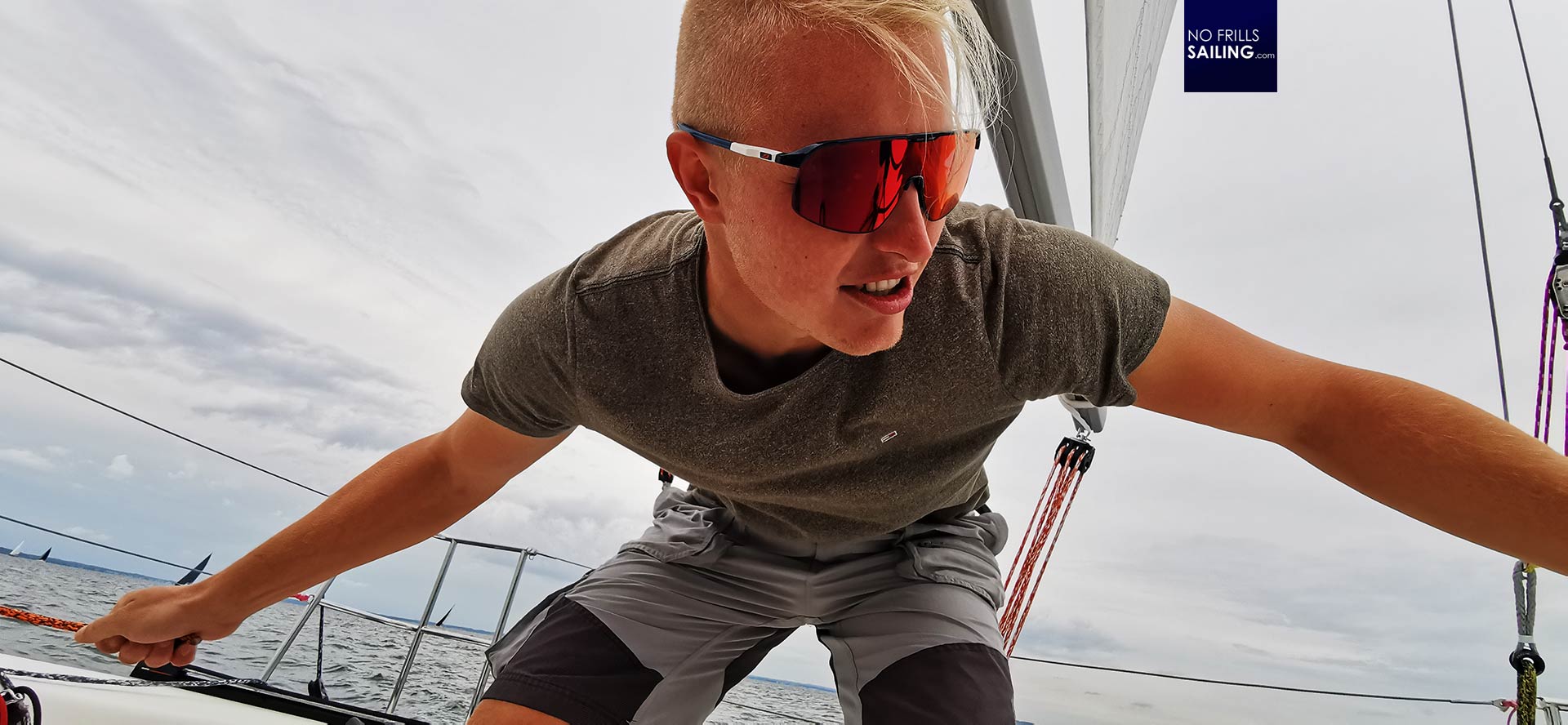
Taking down the Gennaker at full speed, at least for me, was among the most exciting maneuvers to be performed when single handedly sailing. I started to practice in low wind situations and had quite some awful runs, including wrapping my Gennaker around the keel, which is really not funny. Not unless I´ve watched some tutorials where I learned quite a nice step-by-step procedure which helped me to get a nearly 100 percent success rate in getting down the blister completely dry.
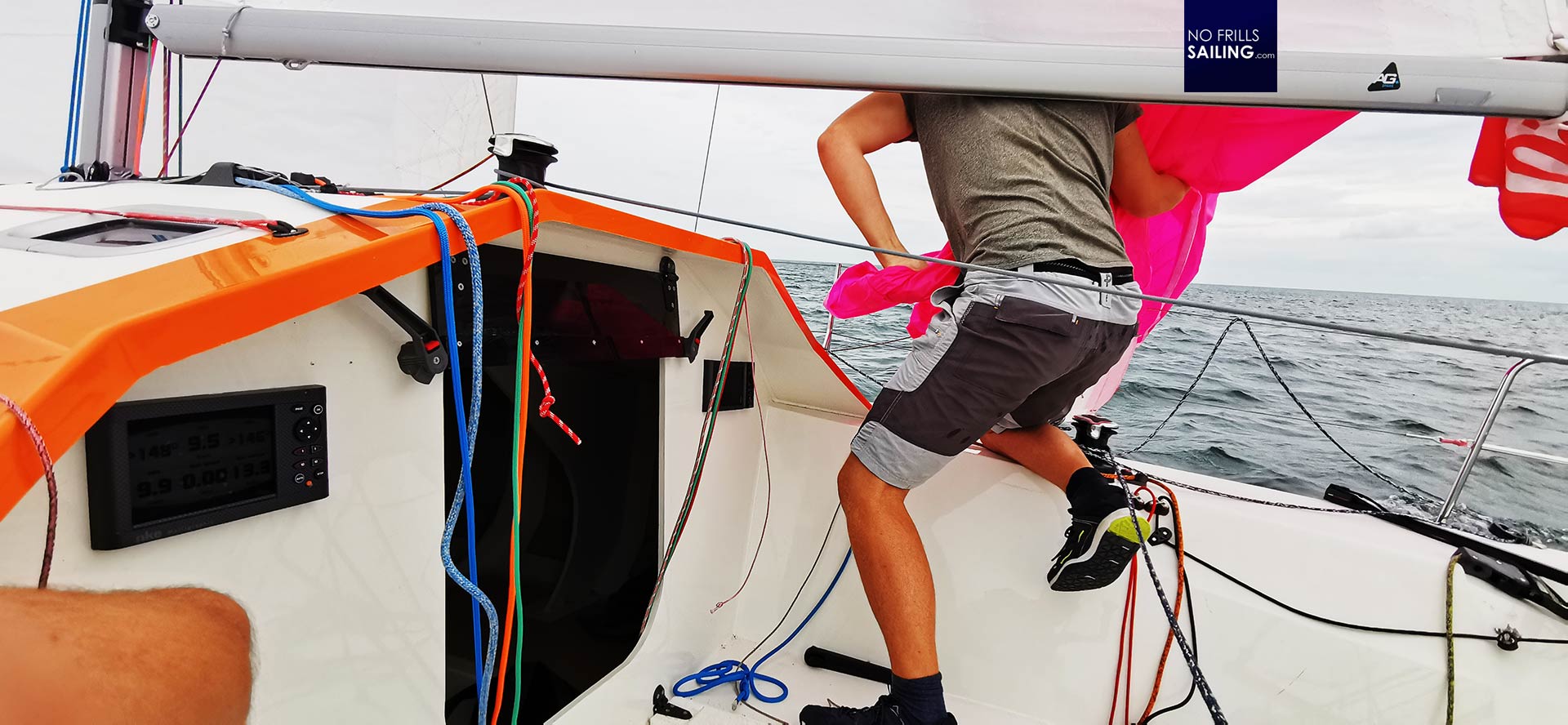
Surprisingly enough Hendrik follows exactly the same steps: Letting out the halyard to be dragged through the water behind the boat (at our speed and wind speed with one turn over the winch to slow the Gennaker-fall even more). Then he lets loose the tack line and drags in the lower part of the Gennaker, only to open the clamp for the halyard and get down the larger rest of the big kite.
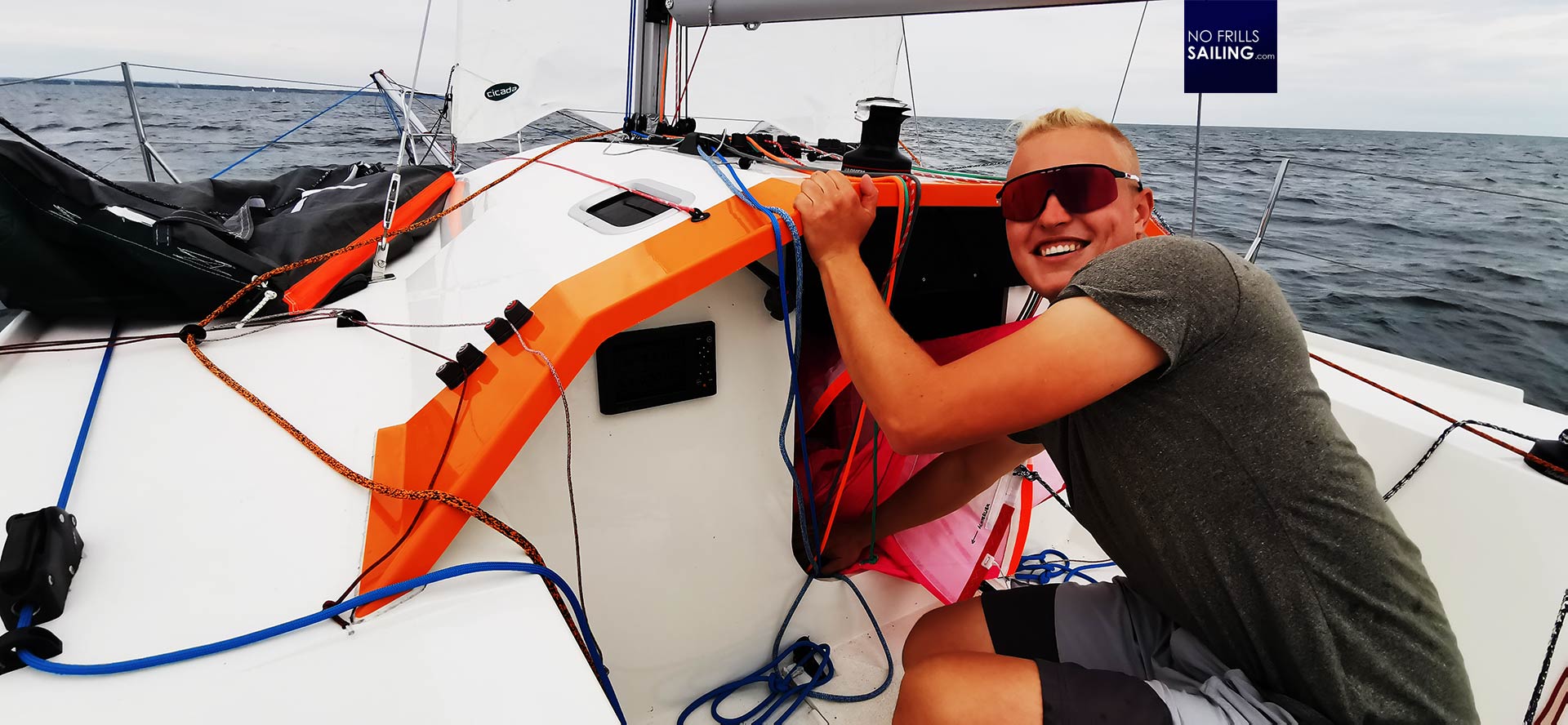
It takes him roughly 30 seconds to get the pink blister down into the bag and below decks. It all looks so effortless and easy, watching him. Besides his work on the lines, with the sails and constantly checking his surroundings for other boats and his course, he always has a chat and a smile to drop on me. Amazing. “Now the fun part starts!”, I announce, knowing what will happen next pretty sure.
Pushing the Mini 6.50 scow-bow upwind
As weh ave dashed downwind for the most part of our little sailing session today, we now have to tack back all the way to Travemuende. Wind speed is now over 20 knots and the boat immediately heels like crazy as he pushes her upwind, sheets in the Jib and main and engages autopilot.
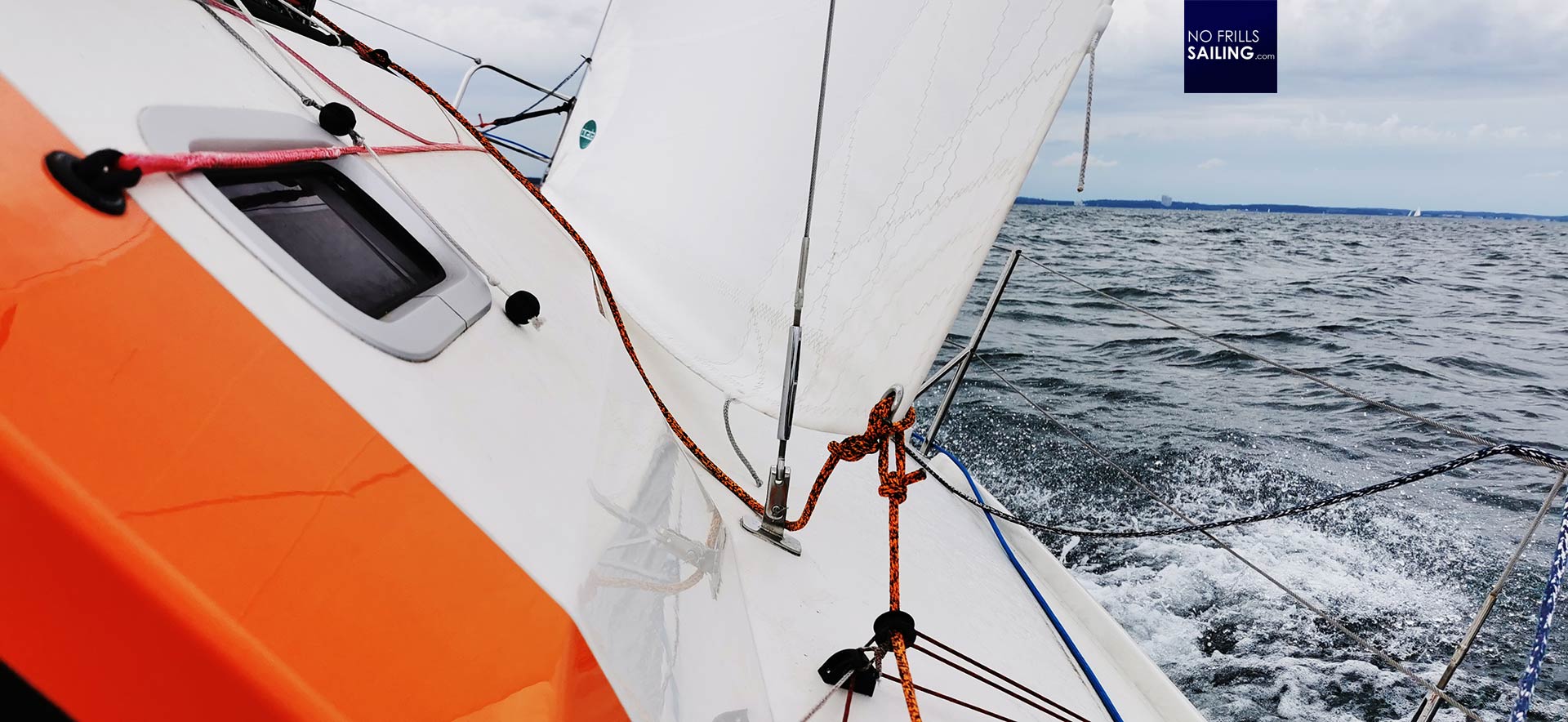
The heeling exceeds 30, 40 degrees easy and as I counterbalance myself on the middle pedestal where the tiller is mounted, Hendrik stands upright onto what used to be the wall of the coamings. This is a heeling angle I would have never accepted in my boat (for the most part because of my kids or my girlfriend but he shows no intention to bear away a bit or at least ease the mainsail.
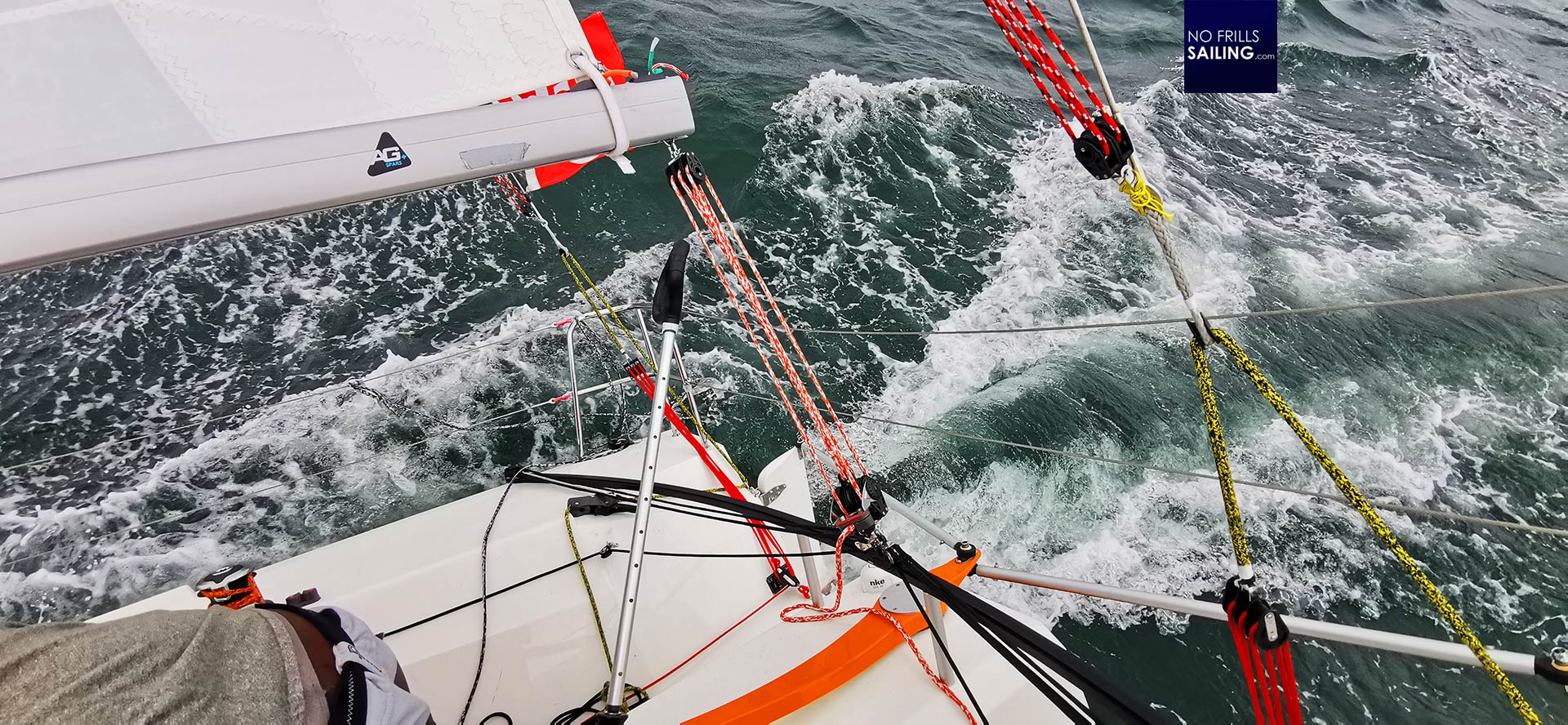
The pressure on the rudders must be extreme: But the autopilot apparently has no problem in holding its due course. In this I understand that Hendrik, something new here, has his autopilot on steer-by-wind and not by steer-by-course mode. This is new to me. But because of the little weight oft he boat, even the slightest change in wind speed or direction is instantaneously translated into a hefty response, keeping a defined wind angle instead of a course seems rational.
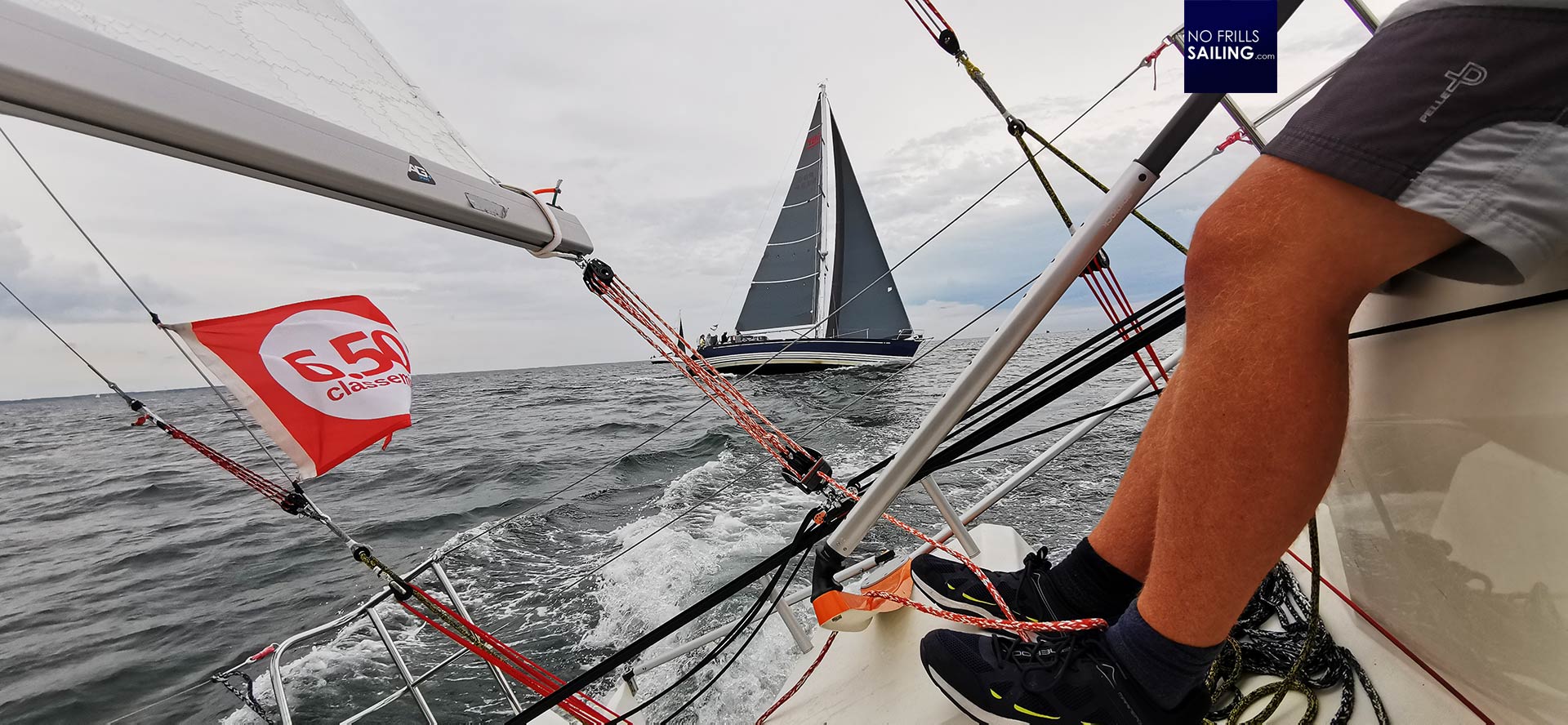
The boat gets a few impressive gusts making me climb even higher and literally sit on the hull, as Hendrik agrees and lets out the main sheet. But just a few centimeters, let´s say, 10 centimeters of line. That´s really enough to ease the main, take out some of the fiercest pressure and get her heeling down a bit. I find this highly interesting – how nimble and responsive this boat reacts, how much knowledge he must have: I would have opened up the main, or let go of the traveler. (I would have put in a reef or two, to be honest …)
Landing in style: Berthing with sails
In all this impressive upwind sailing, the scow boat hits some of the waves pretty hard. The all-too familiar rocking with occasional braking and taking away precious knots occurs. Much less than I had initially expected though. The boat still manages to keep a 6.5 to occasional 7 knots boatspeed which is not so bad for such a small boat indeed! Nevertheless, as we tack our way back to Travemuende harbour, a 40-feet(-ish) X-Yacht clearly can point 5, if not 8 or 10 degrees higher and comes up very fast. The two skippers know each other and so the pass-by is mutually arranged much more dramatic for the camera as one would do.

Surprisingly enough, as we come nearer to the Trave estuary, wind eases again and fast goes down to 5 knots, lucky for us it´s a broad reach to PLAYGIRLS´s berth – remember? We have no engine. I cannot imagine doing this on a regular basis so used to an engine have I become. This is true pure sailing, relying on the wind, sometimes on the current of the river. Al last tack, a last puff and Hendrik takes down the sails.
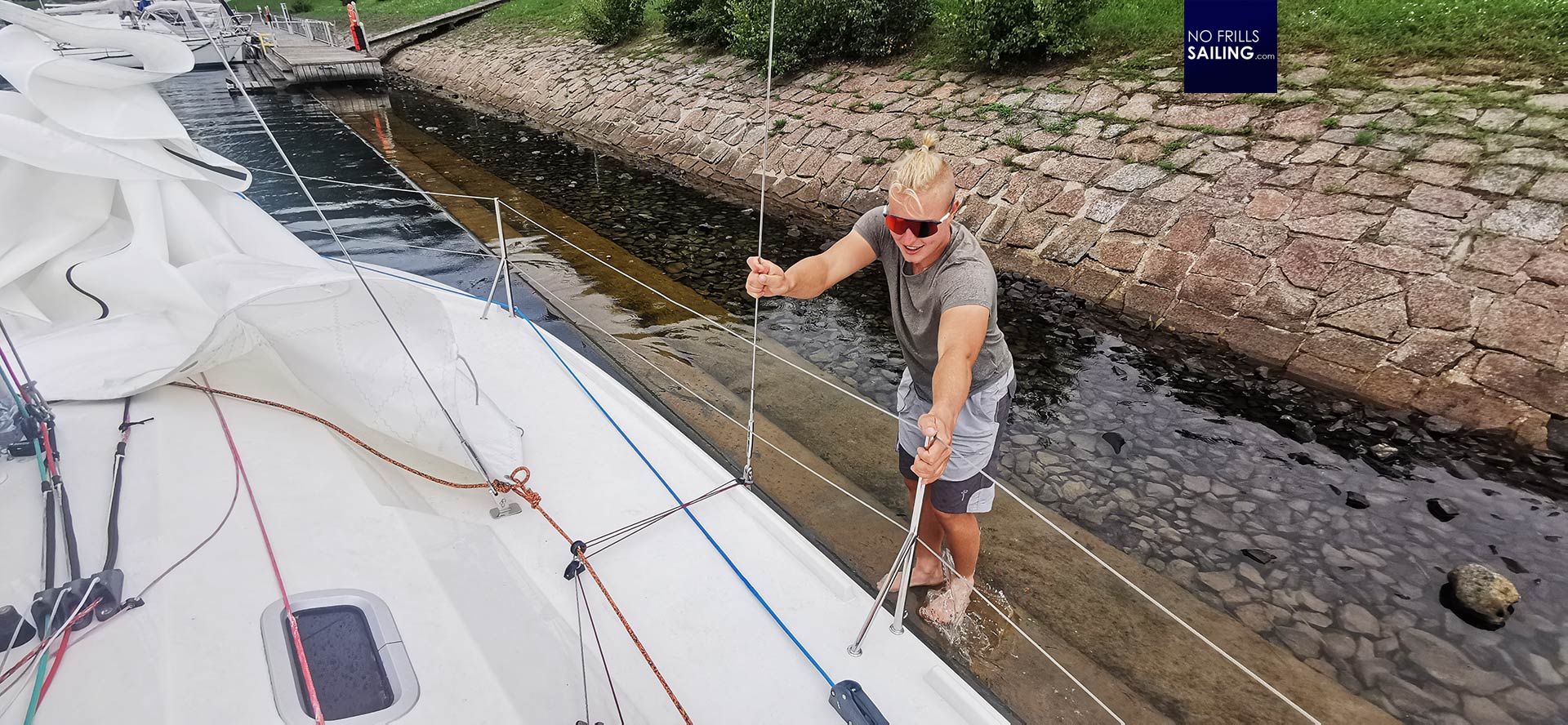
I offer him my paddles which I still have from GEKKO, but he smiles and thankfully declines: “It works perfect that way, I don´t need it” Pumping the rudders to squeeze out at least a bit of headway, the boat manages to hit the right entrance to the harbor bot we drift away from the bollards, which I tried to grab a hold onto. “No problem”, says Hendrik, pulls off his shoes and jumps to the submerged breakwater wall of the opposite side of the basin: “I´ve done it a hundred times, it works …”
Someone´s getting ready for the Mini Transat …
Five minutes later we maneuvered PLAYGIRL back into her berth. It was such an awesome little dash out! As Hendrik is packing the sails and preparing the boat for the night, in a lower voice he admits that a small electric engine “wouldn´t be that bad, to be honest”. But those are expensive. And here´s the Catch 22: As admirably young and reckless as he is, facing the adventures of a solo skipper, as restricted he is budget-wise. Growing older, working our asses off to save some money to buy stuff makes us afford those things, but somehow, on the go, we loose this drive, this fearlessness and joy of tackling the unknown.
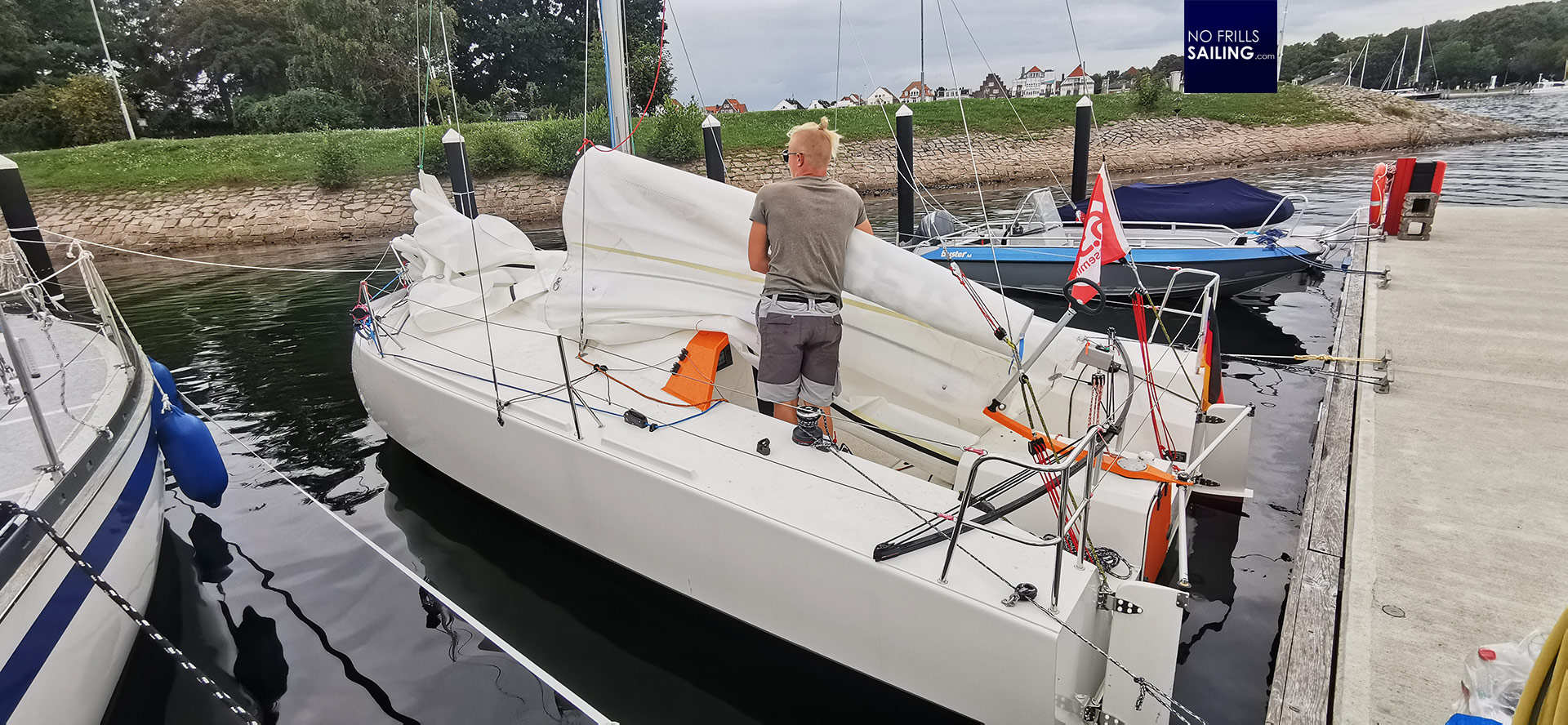
We say Goodbye for today and thank Hendrik for this wonderful sailing day with PLAYGIRL. I learned a lot about Mini 650-handling and calm, confident boat control. Watching Hendrik working the sheets, trimming the sails and managing the boat solo made me gain self confidence as I think I had it done in a similar way myself. “Not bad, old boy”, I think. Thanks, Hendrik, always a pleasure! I wish you and PLAYGIRL a wonderful Vegvisir race, fair winds and be safe!
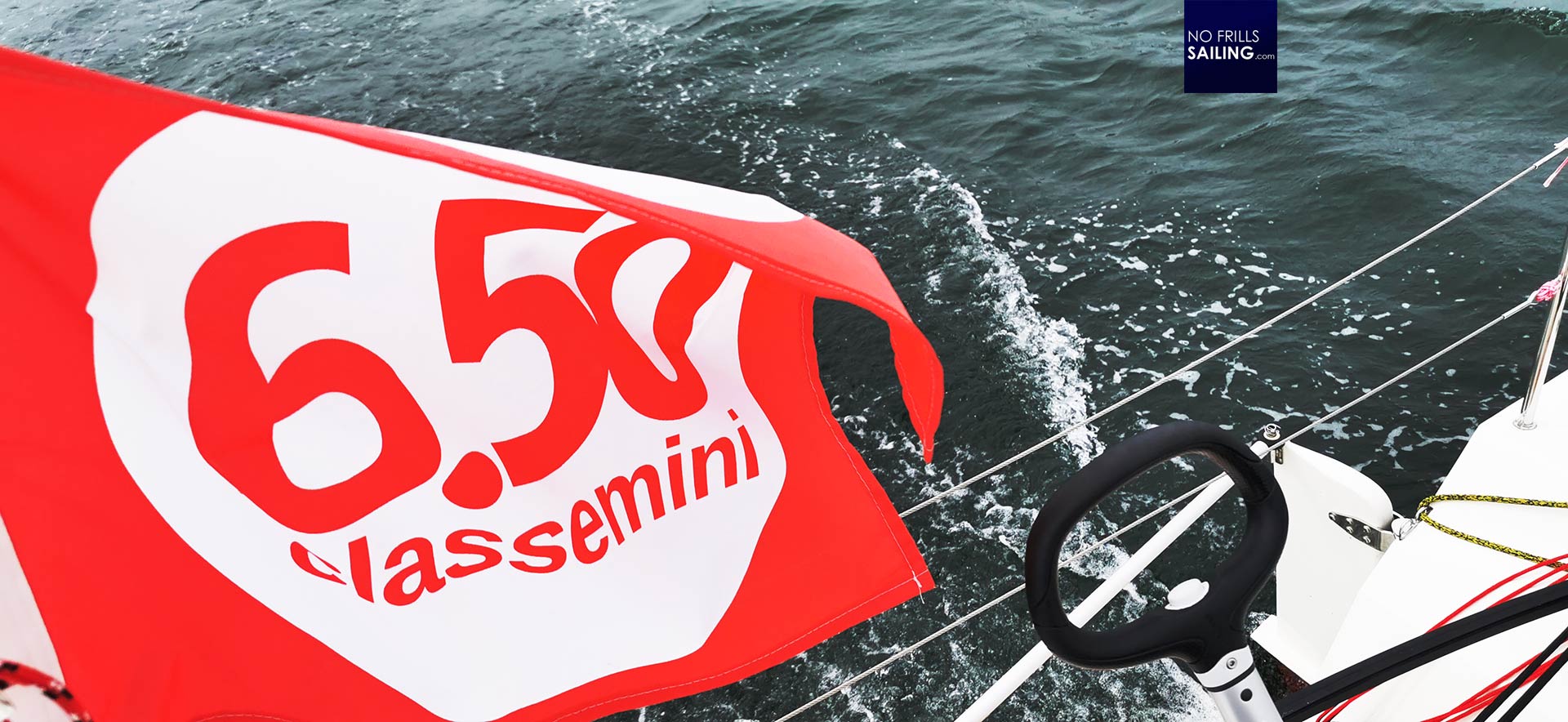
Taking about racing: Henrik´s dream remains the participation in the Mini Transat 2025 and I am sure that this determined young master will make his way to the pontoons of Les Sables. In this, if you seek somebody you can push by a sponsorship or donation – and even if it is “just” a Torqeedo electric engine, this would make a great difference. The same way Hendrik´s bright smile makes me happy, it will certainly be a reward for any person deciding to help him achieve his goal.
You might as well find interesting to read:
Walkthrough of PLAYGIRL freshly delivered from the Vector-yard
Small boat Gennaker retrieval tutorial
Allez, les Minis – at the start of Les Sables-Azores

- Racing Sail Boats
- Racer/Cruiser Sail Boats
- Cruising Sail Boats
- Power Boats
- Super Yachts
- Refits & Restoration
- Composite Solutions
- Metal Works
- Performance Analysis
- Forensic Engineering
- Appendage Refits
The VG-Mini 6.5 2G
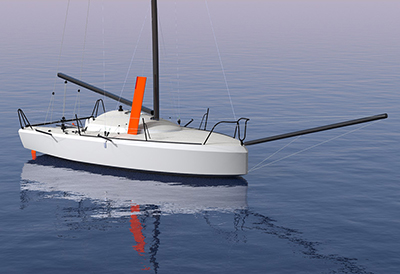
Project Detail
| Specifications: | ||
|---|---|---|
| LOA | 6.50 m | (21′ 4″) |
| LWL | 6.10 m | (20′ 0″) |
| Max Beam | 3.0 m | (9′ 10″) |
| Draft | 2.00 m | (6′ 7″) |
| DSPL | 750 kgs | (1660 lbs) |
| SA (up) | 40 m | (431 ft ) |
| SA (dn) | 93 m | (1001 ft ) |
The Mini Transat Class is arguably experiencing the greatest growth in participation than any other performance sailing yacht class in the world today. The sailing fraternity universally recognizes this class as being the proving ground for young sailors with aspirations of racing around the world on Class 40s and IMOCA 60s. Technically speaking, these boats are extremely sophisticated with the protos pushing the envelope of development within the confines of a relatively unrestrictive and progressive open rule.
After a significant period of research and development, Van Gorkom Yacht Design is excited to be releasing their second generation VG-Mini 6.5 proto. This mini design is a phenomenal little boat and has the potential to dominate the competition and establish a whole new level of performance. All that, and it’s available as a kit-plan-package for the boat building enthusiast.
The all carbon fiber hull and deck incorporates the latest proven trends in hydrodynamics for this ilk of offshore racing boat. The canoe body has a full entrance angle in its forward sections (not quite a scow bow), and a gentle rocker fairing into a defined wide-body chine aft. This optimized configuration will give the boat a significant advantage in terms of raw power and its ability to perform well in a broad range of conditions.
The appendages consist of an 80 degree articulating fin and bulb, and port/stbd asymmetric dagger boards, and twin rudders. The versatility of this arrangement, plus the added water ballast, dramatically adds to the sailing stability and performance of the boat. The keel has a carbon fiber fin supporting a lead bulb. The dagger boards and rudders are also all carbon construction. A foiling version of the boat is presently under development.
The spar, rigging and deck hardware packages have been carefully selected with the latest philosophies in mind coming from today’s top Mini skippers. This kit is the perfect boat building project for the sailor who wants to put together a “from the ground up” performance sailing yacht and be highly competitive at the end of the day.
VGYD is selling the VG-Mini 6.5 2G basic kit-plan-package for US$4,250. See Kit Plans for details.
BoatNews.com
Vector 6.5, scow is popular in Mini

Things are happening in the Mini's little world. After the announcement of the Maxi 6.50 being built by the IDBmarine shipyard, it is the architect Etienne Bertrand who presents us with his new plan, already under construction at Yacht Service. And once again a scow-type hull.
Another round bow! The "sharp ends" probably have a lot to worry about... Etienne Bertrand, the architect well known in the Mini world for having made several Proto before designing the Ofcet 6.50, has just announced the launch of a new Mini of series: the Vector 6.5.
The round bows are popular since the IDBmarine shipyard has already announced in September the launch of the Maxi 6.50, a standard Mini based on David Raison's design ( see our article on Maxi 6.50 ). For his part, Etienne Bertrand had already launched (but without advertising) his Vector 6.5 project on an order from the Yacht Service shipyard .
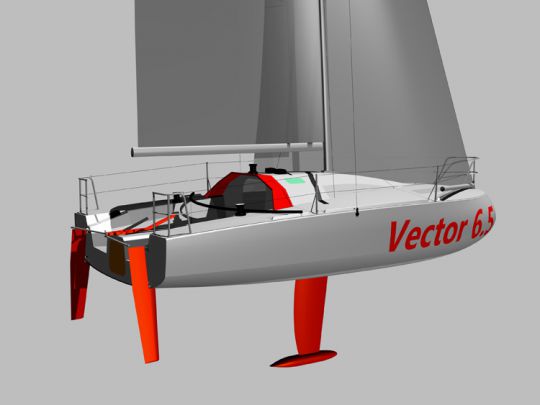
A construction site capable of large volumes
Yacht Service is a Polish shipyard known for its subcontracting in particular for X-Yacht, Brente, or the Eagle, a kind of 14-metre Dragon. This shipyard has put a foot in the Mini by building protos 894 and 931 which finished 5 e of the Mini 2017. But he realized that he was better suited to mass production than prototyping. Hence the order from Etienne Bertrand for a production Mini.
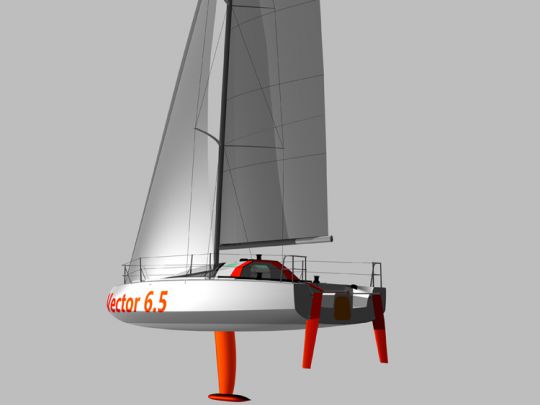
A scow for performance and comfort
As with the Ofcet 6.5, Etienne Bertrand considers that a production Mini must be competitive, but also comfortable to cruise with. Just like the Coco of the time. So for the design of the Vector 6.5, he worked on the idea of a scow (the big round bows), whose qualities are now validated: power, volume, road stability .
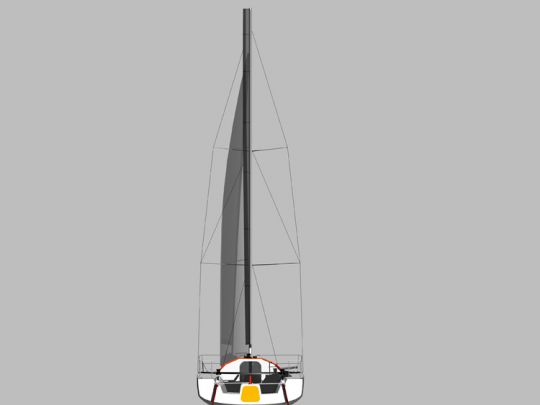
A construction in progress
The shipyard has started and the hull mould is now built. The will of the shipyard is to produce the best boat at the best price. Thus the Vector 6.5 will be built with the best materials available on the market. The rigging will be supplied by AG+, who has collaborated to optimize the geometry of the slotted rigging. It will be fitted with Harken fittings, with 2 possible positions for the mainsail track: either a circular track (which is favoured by the architect), or a conventional stern track.
The first boat will be launched in April 2018 and 3 copies have already been ordered (n°3 will be delivered in early June). This mini will be declared Mini of series for the next Mini 2019 (more than 10 specimens built).
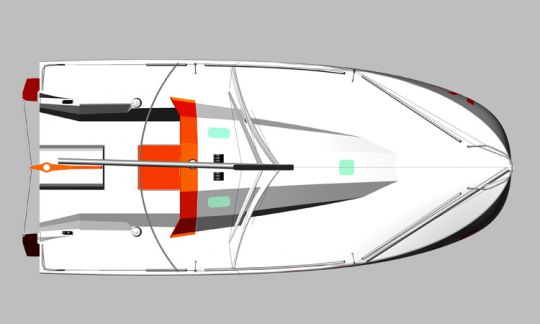
An attractive price
The price is very competitive: 39,000 euros HT for a finished boat (rigged boat with deck fittings without sails or electronics). By way of comparison, the Ofcet 6.50 is available at 44,000 euros HT. The shipyard is working on commercial packs (Trailer pack + conformateur, Electricity pack with lead or lithium batteries, Pilot pack with NKE electronics).
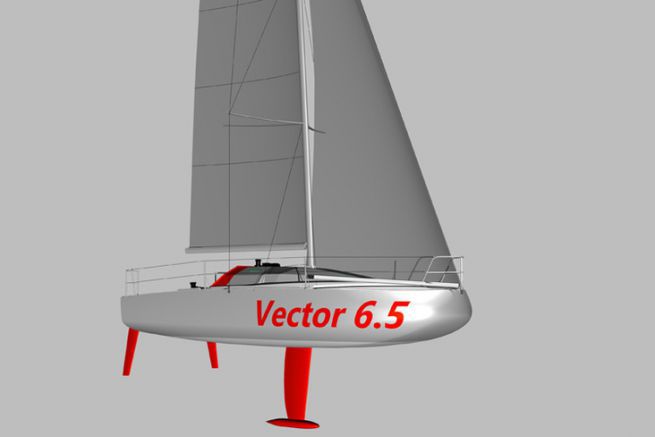

- Melges A Scow
- Melges E Scow
- Melges C Scow
- Melges MC Scow
- Melges X Boat
- O’pen Skiff
- Skeeta & Nikki
- Melges RIB 625C
- Melges Power 26
- About Melges
- Melges Watersports Center
- Quantum Sails Zenda
- Find a Dealer
THE MELGES C SCOW
STRONG ONE-DESIGN FAMILY RACING
THE MELGES C SCOW ®
The Melges C Scow was the first class of scow built by Harry Melges, Sr. in 1945. It quickly became known for cerebral, tactical skills being central to success on the water.
Inspired by more than 100 years of competitive racing, this cat-rigged, maneuverable sailboat is great fun and a total pleasure to sail. A modern, versatile and easy-to-sail boat, it accommodates 2-3 crew and is super-charged with a large, powerful mainsail.
Built with integrity, the Melges C Scow is fast and calibrated superlatively for speed. It is one of the most friendly and popular classes in the Melges Scow family, producing as many as 80+ boats on the starting line.
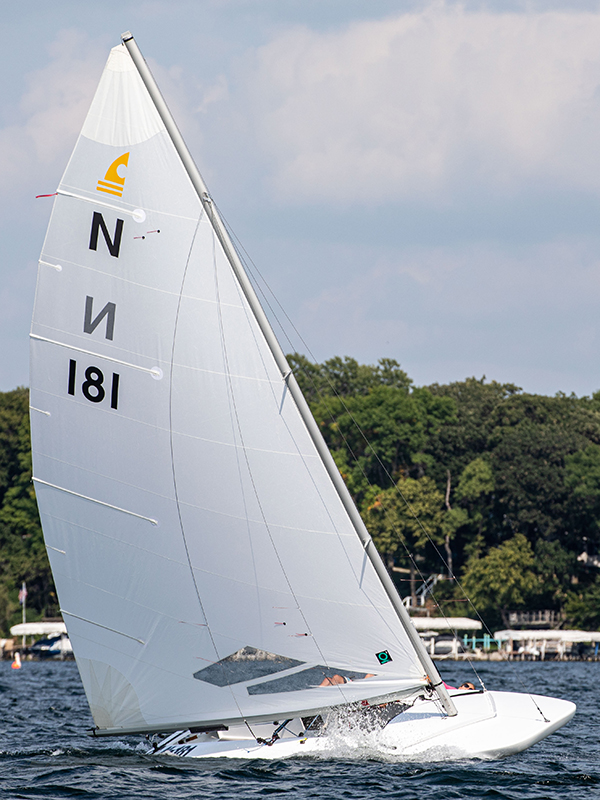
- PRODUCT OVERVIEW
- RACING & CLASS
- TUNING GUIDE
| 20 ft | 6.096 m | |
| 6 ft 9 in | 2.057 m | |
| 650 lbs | 294.835 kg | |
| 216 sq ft | 20.067 m | |
| 2-3 | ||
Class Website
Class Facebook
Quantum Sails – C Scow Sails

Quantum Sails Tuning Guide – Updated November 2020
July 14, 2023
Quantum Sails Leads Summer Events
April 27, 2023
Melges & Quantum Sails Zenda to Host Spring Clinic at Minnetonka Yacht Club
December 6, 2022
Top Upgrades for 2023
January 20, 2022

New Clinics Announced for 2022
Ready to learn more.
WE LOOK FORWARD TO HEARING FROM YOU
Privacy Preference Center
Privacy preferences.
Great choice! Your favorites are temporarily saved for this session. Sign in to save them permanently, access them on any device, and receive relevant alerts.
- Sailboat Guide
M-16 Scow is a 16 ′ 0 ″ / 4.9 m monohull sailboat designed by Johnson/Melges Boat Works and built by Tanzer Industries Ltd., Windward Boatworks, and Melges Performance Sailboats starting in 1950.

Rig and Sails
Auxilary power, accomodations, calculations.
The theoretical maximum speed that a displacement hull can move efficiently through the water is determined by it's waterline length and displacement. It may be unable to reach this speed if the boat is underpowered or heavily loaded, though it may exceed this speed given enough power. Read more.
Classic hull speed formula:
Hull Speed = 1.34 x √LWL
Max Speed/Length ratio = 8.26 ÷ Displacement/Length ratio .311 Hull Speed = Max Speed/Length ratio x √LWL
Sail Area / Displacement Ratio
A measure of the power of the sails relative to the weight of the boat. The higher the number, the higher the performance, but the harder the boat will be to handle. This ratio is a "non-dimensional" value that facilitates comparisons between boats of different types and sizes. Read more.
SA/D = SA ÷ (D ÷ 64) 2/3
- SA : Sail area in square feet, derived by adding the mainsail area to 100% of the foretriangle area (the lateral area above the deck between the mast and the forestay).
- D : Displacement in pounds.
Ballast / Displacement Ratio
A measure of the stability of a boat's hull that suggests how well a monohull will stand up to its sails. The ballast displacement ratio indicates how much of the weight of a boat is placed for maximum stability against capsizing and is an indicator of stiffness and resistance to capsize.
Ballast / Displacement * 100
Displacement / Length Ratio
A measure of the weight of the boat relative to it's length at the waterline. The higher a boat’s D/L ratio, the more easily it will carry a load and the more comfortable its motion will be. The lower a boat's ratio is, the less power it takes to drive the boat to its nominal hull speed or beyond. Read more.
D/L = (D ÷ 2240) ÷ (0.01 x LWL)³
- D: Displacement of the boat in pounds.
- LWL: Waterline length in feet
Comfort Ratio
This ratio assess how quickly and abruptly a boat’s hull reacts to waves in a significant seaway, these being the elements of a boat’s motion most likely to cause seasickness. Read more.
Comfort ratio = D ÷ (.65 x (.7 LWL + .3 LOA) x Beam 1.33 )
- D: Displacement of the boat in pounds
- LOA: Length overall in feet
- Beam: Width of boat at the widest point in feet
Capsize Screening Formula
This formula attempts to indicate whether a given boat might be too wide and light to readily right itself after being overturned in extreme conditions. Read more.
CSV = Beam ÷ ³√(D / 64)
Since 1999, all new M-16’s have been built using the MC SCOW hull and deck molds and now shares other rigging, such as a single rudder, with the MC SCOW. The main sheet traveller has been done away with and the mast no longer rotates.
Sail Area Main: 108 sq.ft. Jib: 39 sq.ft.
Embed this page on your own website by copying and pasting this code.
Discover Related Sailboats

- About Sailboat Guide
©2024 Sea Time Tech, LLC
This site is protected by reCAPTCHA and the Google Privacy Policy and Terms of Service apply.

- Forums New posts Unanswered threads Register Top Posts Email
- What's new New posts New Posts (legacy) Latest activity New media
- Media New media New comments
- Boat Info Downloads Weekly Quiz Topic FAQ 10000boatnames.com
- Classifieds Sell Your Boat Used Gear for Sale
- Parts General Marine Parts Hunter Beneteau Catalina MacGregor Oday
- Help Terms of Use Monday Mail Subscribe Monday Mail Unsubscribe
Johnson Miniscow
- Thread starter RECESS
- Start date May 11, 2009
- Forums for All Owners
- Ask All Sailors
I know what you mean Recess I was eyeballing a neglected Hobie 16. I had one before and really miss it. Problem is where to put all of the toys. I am still able to get out after school during the week for about a 4 hour sail. I noticed that it stays light until 8pm now. One of the great things about working for LAUSD , compared to the private sector, is the short day.
Rig the main sheet using some cheap string to figure out how long it should be. As for diameter, check the block sizes. I cannot imagine it being much more than 3/8" line.
sailormanbigd
ok, I have a Ruben's Nymph (8ft sailing/rowing dinghy) An international Tempest 22 rocketship, an Oday 25, A Morgan 33 Outisland major project, a 17ft canoe, and a 17.5 ft Mckee powerboat. Sailing is an obsession not a sickness!
oh, go buy about 25 ft of 3/8in stayset from West Marine. Its 20% off right now.
- This site uses cookies to help personalise content, tailor your experience and to keep you logged in if you register. By continuing to use this site, you are consenting to our use of cookies. Accept Learn more…
| |
| |




IMAGES
VIDEO
COMMENTS
The Scow-bowed Mini racer. The Vector 6.5 is the latest generation series production Classe Mini 6.50 racer. The boat has been designed by Frenchman Etienne Bertrand in 2017, entering that year´s edition of the Mini Transat race as a prototype, finishing off at an impressive second place. The boat displays latest downwind running optimized ...
Breton yard IDB Marine was one of the forerunners in producing a cruising boat based on a scow bow design. ... David Raison-designed Maxi 650 that won the series division of the last Mini Transat ...
The Skaw Paradise is a very beamy 11.3m foiling scow bow cruiser with its roots firmly in the racing scene, but with the concepts reworked to produce an ultimate cruiser. Skaw CEO and founder ...
1976. Builder (s) Various. Boat. Crew. 1 or 2. [edit on Wikidata] Mini Transat 6.50 also known by a number of alternatives Mini, Class Mini, Transat 650 is a development measurement controlled offshore sailing primarily used for racing in the Mini Transat Race hence the name. [1]
French yacht designer and Mini sailor David Raison has a lot to answer for. His 21ft Magnum scow, designed to the Mini class rule, was one of the most significant steps forward in offshore yacht ...
The Mini 6.50 Class is divided into production boats and the prototypes. Some rules are common to all boats: 6.5m LOA max, 3m beam max, no communication, etc. Prototypes are allowed to have daggerboard, canting keels, ballasts, carbon mast…etc. The mast is also a bit taller (11m instead of 10m for the production boats), the keel a bit lower ...
The speed potential of a Mini 6.50 Scow. We started today at some 10 knots TWS on a beam reach of which the boat utilized roughly 7.5 to 8.5 knots under standard sails. This is pretty impressive. ... In all this impressive upwind sailing, the scow boat hits some of the waves pretty hard. The all-too familiar rocking with occasional braking and ...
Johnson Boat Works (USA) Founded by John O. Johnson, famed builder and designer of racing scows. Located at White Bear Lake, Minnesota, USA. The company was in business for more than 100 years! Years in Business: 1896 - 1998.
This kit is the perfect boat building project for the sailor who wants to put together a "from the ground up" performance sailing yacht and be highly competitive at the end of the day. VGYD is selling the VG-Mini 6.5 2G basic kit-plan-package for US$4,250. See Kit Plans for details. Van Gorkom Yacht Design is releasing their second ...
This mini will be declared Mini of series for the next Mini 2019 (more than 10 specimens built). Vector 6.5 An attractive price . The price is very competitive: 39,000 euros HT for a finished boat (rigged boat with deck fittings without sails or electronics). By way of comparison, the Ofcet 6.50 is available at 44,000 euros HT.
THE MELGES C SCOW®. The Melges C Scow was the first class of scow built by Harry Melges, Sr. in 1945. It quickly became known for cerebral, tactical skills being central to success on the water. Inspired by more than 100 years of competitive racing, this cat-rigged, maneuverable sailboat is great fun and a total pleasure to sail.
Johnson Boat Works was a builder and developer of racing sailboats of the scow design in White Bear Lake, Minnesota.It was founded in 1896, by John O. Johnson who had emigrated from Norway in 1893. After working with Gus Amundson [who?] for three years, Johnson started his own boat-building business in 1896. His first major success was the "Minnezika" a 38 ft scow design which won the ...
MC Scow: Download Boat Record: Notes. Based on the J SCOW of the the mid-1950's. (Designed and built by John O. Johnson). ... 1997), states that a boat with a BN of less than 1.3 will be slow in light winds. A boat with a BN of 1.6 or greater is a boat that will be reefed often in offshore cruising. Derek Harvey, "Multihulls for Cruising and ...
The largest of the inland racing scows sailed in mid-western USA. Nominally a one-design class, today's 'A' Class Scow is the result of a long evolutionary path with origins that can be traced to a prototype that appeared in 1896. (Designed and built by John O. Johnson, original founder of Johnson Boat Works, a major builder of scows for ...
M-16 Scow is a 16′ 0″ / 4.9 m monohull sailboat designed by Johnson/Melges Boat Works and built by Tanzer Industries Ltd., Windward Boatworks, and Melges Performance Sailboats starting in 1950. ... Since 1999, all new M-16's have been built using the MC SCOW hull and deck molds and now shares other rigging, such as a single rudder, with ...
Three sailboats now (25', 10' dinghy, 12' scow) there is a special sickness to sailing. Any info appreciated. caguy. Sep 22, 2006 4,004 Catalina, Luger C-27, Adventure 30 Marina del Rey May 11, 2009 #2 I know what you mean Recess I was eyeballing a neglected Hobie 16. I had one before and really miss it.
The scow sloop eventually evolved into the inland lake scow, a type of fast racing boat. Sailing scows were popular in the American South for economic reasons, because the pine planks found there were difficult to bend, and because inlets along the Gulf Coast and Florida were often shallow. ... The MC is a "mini-C" of sorts, a 16-foot cat ...
Johnson Mini-Scow, 1985, Erie, Illinois, yacht for sale, sailboat for sale ... Sails: Scam Warnings: Texas Lakes: Advertise with us: Contact: Free Sailboat Ad: Go to Sailing Texas classifieds for current sailboats for sale . Johnson Mini-Scow, 1985 good shape, trailer included . decent sail. The boat is located in Erie Il. Thank You for Looking ...
Mini Scow. Discussion in 'Sailboats' started by DiasDePlaya, Jul 9, 2010. Joined: Apr 2010 Posts: 13 Likes: 0, Points: 0, Legacy Rep: 10 Location: Chile DiasDePlaya Junior ... Now I'm competing in radio controlled boats "Victoria" class and I'm thinking about building a RG-65.
April 16, 2012. 0 shares. The latest hot trend in ocean racing design is the scow bow. But it's ugly and it looks as if it'd be brutal upwind. I'm torn when I think about the latest trend for ...
The scow shape for Mini's began with David Raisons boat a few years ago and has proven to be very fast. The newest versions like Arkema and SeAir have taken another major leap in technology utilizing lifting foils to completely fly the boat. ... In some ways, something like a 25 foot scow is often simply a 28 foot boat with the bow chopped off ...
Show all sailboats for sale under: 15 20 25 30 35 40 45 50 55 60 70 80 (feet LOA) | Multihulls: Catamarans Trimarans. Sorry: No Sailboats Match Your Query, or the sailboat previously listed under these criteria has now been sold. Please navigate from the menu above or search for newly listed preowned sailboats matching your specifications: